The Effect of CO2 Phase on Oil Displacement in a Sandstone Core Sample
Abstract
:1. Introduction
2. Materials and Experimental Setup
2.1. Experimental Setup
2.2. CO2–Oil Displacement Procedure
- (1)
- The core sample was wrapped into a shrinkable Teflon tube followed by a rubber sleeve and then fixed inside the core holder. The core holder was mounted horizontally inside the water bath.
- (2)
- To prevent fluid bypassing, a confining pressure of about 135 bar, which is always higher than the pore pressure, was applied to the core with the confining pump. The temperature was controlled by the heater.
- (3)
- The vacuum pump was connected to the system to remove the trapped gas.
- (4)
- To fully saturate the core sample with oil, about 40–60 pore volumes (PVs) of oil were injected at a high-differential pressure of 80–90 bar.
- (5)
- To obtain heat equilibrium, the water bath temperature was set to the required temperature and the system was left overnight for the temperature to stabilize.
- (6)
- Prior to each flooding experiment, a constant pressure was applied to the entire system using the syringe pump at each end.
- (7)
- After reaching the experimental pressure, the system was left for about 20 min to ensure that temperature stabilization had been achieved throughout the system.
- (8)
- The mode of the injected pump (ISCO pump CO2) was changed from a constant pressure mode to a constant flow rate mode to inject CO2 into the core at a constant injection rate to displace the saturated oil. The injected CO2 volumes and the collected volumes were recorded every 30 s.
- (9)
- During the experiment, the inlet and outlet pressure transducer readings were recorded every 6 s, using the LabVIEW software, in order to calculate the differential pressure across the core sample.
- (10)
- When the experiment was finished, the produced volumes were measured to calculate the residual oil saturation with mass balance. Later, the weight of the core sample was measured using a Sartorius weighing scale with a resolution of 0.0001 g to confirm the residual oil saturation measurements.
3. Results and Discussion
3.1. The Pressure Behavior of CO2–Oil Displacements as a Function of CO2 Phase
3.1.1. The Effect of Fluid Pressure on the Differential Pressure Profile of CO2–Oil Displacements
3.1.2. The Effect of Temperature on the Differential Pressure Profile of CO2–Oil Displacements
3.1.3. The Effect of Injection Rate on the Differential Pressure Profile of CO2–Oil Displacements
3.2. The Production Behaviur of CO2–Oil Displacements as a Function of CO2 Phase
3.2.1. The Effect of Fluid Pressure on Production Behaviour of CO2–Oil Displacement
3.2.2. The Effect of Experimental Temperature on the Differential Pressure Profile of CO2–Oil Displacements
3.3. The Effect of Fluid Pressure, Temperature, and Injection Rate on Endpoint Effective (Relative) Permeability and Residual Oil Saturation as a Function of CO2 Phase
4. Conclusions
Acknowledgments
Author Contributions
Conflicts of Interest
References
- Alvarado, V.; Manrique, E. Enhanced oil recovery: An update review. Energies 2010, 3, 1529–1575. [Google Scholar] [CrossRef]
- Emadi, A.; Sohrabi, M.; Farzaneh, S.A.; Ireland, S. (Eds.) Experimental Investigation of Liquid-CO2 and CO2-Emulsion Application for Enhanced Heavy Oil Recovery. In Proceedings of the EAGE Annual Conference & Exhibition incorporating SPE Europec, London, UK, 10–13 June 2013; Society of Petroleum Engineers: Houston, TX, USA, 2013. [Google Scholar]
- Srivastava, R.; Huang, S.; Dyer, S.; Mourits, F. (Eds.) Heavy oil recovery by subcritical carbon dioxide flooding. In Proceedings of the SPE Latin America/Caribbean Petroleum Engineering Conference, Buenos Aires, Argentina, 27–29 April 1994; Society of Petroleum Engineers: Houston, TX, USA, 1994. [Google Scholar]
- Tahmasebi, P.; Sahimi, M.; Kohanpur, A.H.; Valocchi, A. Pore-scale simulation of flow of CO2 and brine in reconstructed and actual 3D rock cores. J. Petrol. Sci. Eng. 2017, 155, 21–33. [Google Scholar] [CrossRef]
- Liu, Y.; Teng, Y.; Jiang, L.; Zhao, J.; Zhang, Y.; Wang, D.; Song, Y. Displacement front behavior of near miscible CO2 flooding in decane saturated synthetic sandstone cores revealed by magnetic resonance imaging. Magn. Resonance Imaging 2017, 37, 171–178. [Google Scholar] [CrossRef] [PubMed]
- Vega, B.; Kovscek, A.R. Carbon dioxide (CO2) sequestration in oil and gas reservoirs and use for enhanced oil recovery (EOR). In Developments and Innovation in Carbon Dioxide (CO2) Capture and Storage Technology; Woodhead Publishing: Sawston, UK, 2010; Volume 2, pp. 104–126. [Google Scholar]
- Moortgat, J.B.; Firoozabadi, A.; Li, Z.; Espósito, R.O. CO2 injection in vertical and horizontal cores: Measurements and numerical simulation. SPE J. 2013, 18, 331–344. [Google Scholar] [CrossRef]
- Klins, M.A.; Ali, S.M.F. Heavy Oil Production by Carbon Dioxide Injection. J. Can. Petrol. Technol. 1982, 21. [Google Scholar] [CrossRef]
- Todd, M.; Grand, G. Enhanced oil recovery using carbon dioxide. Energy Conv. Manag. 1993, 34, 1157–1164. [Google Scholar] [CrossRef]
- Huang, E.T.; Tracht, J.H. (Eds.) The displacement of residual oil by carbon dioxide. In Proceedings of the SPE Improved Oil Recovery Symposium, Tulsa, Oklahoma, 22–24 April 1974; Society of Petroleum Engineers: Houston, TX, USA, 1974. [Google Scholar]
- Spivak, A.; Garrison, W.H.; Nguyen, J.P. Review of an immiscible CO2 project, tar zone, fault block V, Wilmington field, California. SPE Reserv. Eng. 1990, 5, 155–162. [Google Scholar] [CrossRef]
- Hao, H.; Hou, J.; Zhao, F.; Song, Z.; Hou, L.; Wang, Z. Gas channeling control during CO2 immiscible flooding in 3D radial flow model with complex fractures and heterogeneity. J. Pet. Sci. Eng. 2016, 146 (Suppl. C), 890–901. [Google Scholar] [CrossRef]
- Yellig, W.; Metcalfe, R. Determination and Prediction of CO2 Minimum Miscibility Pressures. J. Pet. Technol. 1980, 32, 160–168. [Google Scholar] [CrossRef]
- Tran, T.Q.M.D.; Neogi, P.; Bai, B. Stability of CO2 Displacement of an Immiscible Heavy Oil in a Reservoir. SPE J. 2017, 22. [Google Scholar] [CrossRef]
- Ren, B.; Xu, Y.; Ren, S.; Li, X.; Guo, P.; Song, X. (Eds.) Laboratory assessment and field pilot of near miscible CO2 injection for IOR and storage in a tight oil reservoir of ShengLi Oilfield China. In Proceedings of the SPE Enhanced Oil Recovery Conference, Kuala Lumpur, Malaysia, 9–21 July 2011; Society of Petroleum Engineers: Houston, TX, USA, 2011. [Google Scholar]
- Stalkup, F. Carbon dioxide miscible flooding: Past, present, and outlook for the future. J. Petrol. Technol. 1978, 30, 1102–1112. [Google Scholar] [CrossRef]
- Bui, L.H. Near Miscible CO2 Application to Improve Oil Recovery. Ph.D. Thesis, University of Kansas, Lawrence, KS, USA, 2010. [Google Scholar]
- Shyeh-Yung, J. (Ed.) Mechanisms of miscible oil recovery: Effects of pressure on miscible and near-miscible displacements of oil by carbon dioxide. In Proceedings of the SPE Annual Technical Conference and Exhibition, Dallas, TX, USA, 6–9 October 1991; Society of Petroleum Engineers: Houston, TX, USA, 1991. [Google Scholar]
- Khatib, A.K.; Earlougher, R.C.; Kantar, K. CO2 Injection As An Immiscible Application For Enhanced Recovery In Heavy Oil Reservoirs. 1981/1/1/. In Proceedings of the SPE California Regional Meeting, Bakersfield, CA, USA, 25–27 March 1981; Society of Petroleum Engineers: Houston, TX, USA, 1981. [Google Scholar]
- Rojas, G.; Ali, S. Dynamics of subcritical CO2/brine floods for heavy-oil recovery. SPE Reserv. Eng. 1988, 3, 35–44. [Google Scholar] [CrossRef]
- Hatchell, D.; Benson, S. Examining the Potential of Immiscible CO2 for Gravity-assisted Enhanced Oil Recovery and Storage. Energy Procedia 2017, 114, 6980–6988. [Google Scholar] [CrossRef]
- Espinoza, D.N.; Santamarina, J.C. Water-CO2-mineral systems: Interfacial tension, contact angle, and diffusion—Implications to CO2 geological storage. Water Resour. Res. 2010, 46. [Google Scholar] [CrossRef]
- Bachu, S. Sequestration of CO2 in geological media: Criteria and approach for site selection in response to climate change. Energy Conv. Manag. 2000, 41, 953–970. [Google Scholar] [CrossRef]
- Saraji, S.; Piri, M.; Goual, L. The effects of SO2 contamination, brine salinity, pressure, and temperature on dynamic contact angles and interfacial tension of supercritical CO2/brine/quartz systems. Int. J. Greenh. Gas Control 2014, 28, 147–155. [Google Scholar] [CrossRef]
- Sohrabi, M.; Jamiolahmady, M.; Al Quraini, A. (Eds.) Heavy Oil Recovery by Liquid CO2/Water Injection. In Proceedings of the EUROPEC/EAGE Conference and Exhibition, London, UK, 11–14 June 2007; Society of Petroleum Engineers: Houston, TX, USA, 2007. [Google Scholar]
- Nourpour Aghbash, V.; Ahmadi, M. (Eds.) Evaluation of CO2-EOR and Sequestration in Alaska West Sak Reservoir Using Four-Phase Simulation Model. In Proceedings of the SPE Western Regional Meeting, Bakersfield, CA, USA, 21–23 March 2012; Society of Petroleum Engineers: Houston, TX, USA, 2012. [Google Scholar]
- Frailey, S.M.; Grube, J.P.; Seyler, B.; Finley, R.J. (Eds.) Investigation of liquid CO2 sequestration and EOR in low temperature oil reservoirs in the Illinois basin. In Proceedings of the SPE/DOE Symposium on Improved Oil Recovery, Tulsa, OK, USA, 17–21 April 2004; Society of Petroleum Engineers: Houston, TX, USA, 2004. [Google Scholar]
- Bachu, S.; Bennion, D.B. Interfacial tension between CO2, freshwater, and brine in the range of pressure from (2 to 27) MPa, temperature from (20 to 125) °C, and water salinity from (0 to 334,000) mg·L−1. J. Chem. Eng. Data 2008, 54, 765–775. [Google Scholar] [CrossRef]
- Chun, B.-S.; Wilkinson, G.T. Interfacial tension in high-pressure carbon dioxide mixtures. Ind. Eng. Chem. Res. 1995, 34, 4371–4377. [Google Scholar] [CrossRef]
- Yang, D.; Tontiwachwuthikul, P.; Gu, Y. Interfacial interactions between reservoir brine and CO2 at high pressures and elevated temperatures. Energy Fuels 2005, 19, 216–223. [Google Scholar] [CrossRef]
- Chi, S.; Morsi, B.; Klinzing, G.; Chiang, S. Study of interfacial properties in the liquid carbon dioxide-water-coal system. Energy Fuels 1988, 2, 141–145. [Google Scholar] [CrossRef]
- Plug, W.-J.; Bruining, J. Capillary pressure for the sand–CO2–water system under various pressure conditions. Application to CO2 sequestration. Adv. Water Resour. 2007, 30, 2339–2353. [Google Scholar] [CrossRef]
- Suekane, T.; Ishii, T.; Tsushima, S.; Hirai, S. Migration of CO2 in Porous Media Filled with water. J. Therm. Sci. Technol. 2006, 1, 1–11. [Google Scholar] [CrossRef]
- Riazi, M.; Sohrabi, M.; Bernstone, C.; Jamiolahmady, M.; Ireland, S. Visualisation of mechanisms involved in CO2 injection and storage in hydrocarbon reservoirsand water-bearing aquifers. Chem. Eng. Res. Des. 2011, 89, 1827–1840. [Google Scholar] [CrossRef]
- Müller, N. Supercritical CO2-brine relative permeability experiments in reservoir rocks—Literature review and recommendations. Transp. Porous Media 2011, 87, 367–383. [Google Scholar] [CrossRef]
- Mijic, A.; LaForce, T.C.; Muggeridge, A.H. CO2 injectivity in saline aquifers: The impact of non-Darcy flow, phase miscibility, and gas compressibility. Water Resour. Res. 2014, 50, 4163–4185. [Google Scholar] [CrossRef]
- Kang, S.; Gao, C.; Zhang, S. Scientific Research and Field Application of CO2 Immiscible Flooding in Heavy Oil Recovery. 2013/7/2/. In Proceedings of the SPE Enhanced Oil Recovery Conference, Kuala Lumpur, Malaysia, 2–4 July 2013; Society of Petroleum Engineers: Houston, TX, USA, 2013. [Google Scholar]
- Rathmell, J.; Stalkup, F.; Hassinger, R. (Eds.) A laboratory investigation of miscible displacement by carbon dioxide. In Proceedings of the Fall Meeting of the Society of Petroleum Engineers of AIME, New Orleans, LA, USA, 3–6 October 1971; Society of Petroleum Engineers: Houston, TX, USA, 1971. [Google Scholar]
- Beeson, D.M.; Ortloff, G.D. Laboratory Investigation of the Water-Driven Carbon Dioxide Process for Oil Recovery. J. Petrol. Technol. 1959, 11, 63–66. [Google Scholar] [CrossRef]
- Wang, X.; Gu, Y. Oil Recovery and Permeability Reduction of a Tight Sandstone Reservoir in Immiscible and Miscible CO2 Flooding Processes. Ind. Eng. Chem. Res. 2011, 50, 2388–2399. [Google Scholar] [CrossRef]
- Jha, K. A laboratory study of heavy oil recovery with carbon dioxide. J. Can. Petrol. Technol. 1986, 25. [Google Scholar] [CrossRef]
- Klins, M.A.; Ali, S.M.F. Oil Production in Shallow Reservoirs By Carbon Dioxide Injection. 1981/1/1/. In In Proceedings of the SPE Eastern Regional Meeting, Columbus, Ohio, 4–6 November 1981; Society of Petroleum Engineers: Houston, TX, USA, 1981. [Google Scholar]
- Tuo, Z.; Xuewei, L.; Zhengming, Y.; Xizhe, L.; Shuying, W. Experimental analysis on reservoir blockage mechanism for CO2 flooding. Petrol. Explor. Dev. 2015, 42, 548–553. [Google Scholar]
- Sankur, V.; Creek, J.L.; Di Julio, S.S.; Emanuel, A.S. A Laboratory Study of Wilmington Tar Zone CO2 Injection Project. SPE Reserv. Eng. 1986, 1, 95–104. [Google Scholar] [CrossRef]
- Moradi, B.; Awang, M.; Sabil, K.; Shoushtari, M.; Moradi, P.; Ajdari, H.; Shuker, M.T. (Eds.) Liquid carbon dioxide flooding in low temperature oil reservoirs. In Proceedings of the SPE Asia Pacific Oil and Gas Conference and Exhibition, Jakarta, Indonesia, 22–24 October 2013; Society of Petroleum Engineers: Houston, TX, USA, 2013. [Google Scholar]
- Arshad, A.; Al-Majed, A.A.; Menouar, H.; Muhammadain, A.M.; Mtawaa, B. Carbon Dioxide (CO2) Miscible Flooding in Tight Oil Reservoirs: A Case Study. 2009/1/1/. In Proceedings of the SPE Kuwait International Petroleum Conference and Exhibition, Kuwait City, Kuwait, 14–16 December 2009; Society of Petroleum Engineers: Houston, TX, USA, 2009. [Google Scholar]
- Chung, F.; Jones, R.; Burchfield, T. (Eds.) Recovery of viscous oil under high pressure by CO2 displacement: A laboratory study. In Proceedings of the International Meeting on Petroleum Engineering, Tianjin, China, 1–4 November 1988; Society of Petroleum Engineers: Houston, TX, USA, 1988. [Google Scholar]
- Cao, M.; Gu, Y. Oil recovery mechanisms and asphaltene precipitation phenomenon in immiscible and miscible CO2 flooding processes. Fuel 2013, 109, 157–166. [Google Scholar] [CrossRef]
- Lashkarbolooki, M.; Vaezian, A.; Hezave, A.Z.; Ayatollahi, S.; Riazi, M. Experimental investigation of the influence of supercritical carbon dioxide and supercritical nitrogen injection on tertiary live-oil recovery. J. Supercrit. Fluids 2016, 117, 260–269. [Google Scholar] [CrossRef]
- Bayat, M.; Lashkarbolooki, M.; Hezave, A.Z.; Ayatollahi, S. Investigation of gas injection flooding performance as enhanced oil recovery method. J. Nat. Gas Sci. Eng. 2016, 29 (Suppl. C), 37–45. [Google Scholar] [CrossRef]
- Rezaei, N.; Firoozabadi, A. Pressure evolution and production performance of waterflooding in n-heptane-saturated fired berea cores. SPE J. 2014, 19, 674–686. [Google Scholar] [CrossRef]
- Alkan, H.; Cinar, Y.; Ülker, E. Impact of capillary pressure, salinity and in situ conditions on CO2 injection into saline aquifers. Transp. Porous Media 2010, 84, 799–819. [Google Scholar] [CrossRef]
- Bikkina, P.; Wan, J.; Kim, Y.; Kneafsey, T.J.; Tokunaga, T.K. Influence of wettability and permeability heterogeneity on miscible CO2 flooding efficiency. Fuel 2016, 166, 219–226. [Google Scholar] [CrossRef]
- Chatzis, I.; Morrow, N.R. Correlation of capillary number relationships for sandstone. Soc. Petrol. Eng. J. 1984, 24, 555–562. [Google Scholar] [CrossRef]
- Fulcher, R.A., Jr.; Ertekin, T.; Stahl, C. Effect of capillary number and its constituents on two-phase relative permeability curves. J. Petrol. Technol. 1985, 37, 249–260. [Google Scholar] [CrossRef]
- Akbarabadi, M.; Piri, M. Relative permeability hysteresis and capillary trapping characteristics of supercritical CO2/brine systems: An experimental study at reservoir conditions. Adv. Water Resour. 2013, 52, 190–206. [Google Scholar] [CrossRef]
- Schembre, J.M.; Kovscek, A.R. A technique for measuring two-phase relative permeability in porous media via X-ray CT measurements. J. Petrol. Sci. Eng. 2003, 39, 159–174. [Google Scholar] [CrossRef]
- Chiquet, P.; Broseta, D.F.; Thibeau, S. (Eds.) Capillary alteration of shaly caprocks by carbon dioxide. In Proceedings of the SPE Europec/EAGE Annual Conference, Madrid, Spain, 13–16 June 2005; Society of Petroleum Engineers: Houston, TX, USA, 2005. [Google Scholar]
- Chiquet, P.; Daridon, J.-L.; Broseta, D.; Thibeau, S. CO2/water interfacial tensions under pressure and temperature conditions of CO2 geological storage. Energy Conv. Manag. 2007, 48, 736–744. [Google Scholar] [CrossRef]
- Farokhpoor, R.; Bjørkvik, B.J.A.; Lindeberg, E.; Torsæter, O. Wettability behaviour of CO2 at storage conditions. Int. J. Greenh. Gas Control 2013, 12, 18–25. [Google Scholar] [CrossRef]
- Han, F.; Busch, A.; van Wageningen, N.; Yang, J.; Liu, Z.; Krooss, B.M. Experimental study of gas and water transport processes in the inter-cleat (matrix) system of coal: Anthracite from Qinshui Basin, China. Int. J. Coal Geol. 2010, 81, 128–138. [Google Scholar] [CrossRef]
- Li, X. Experimental Studies on Pore Wetting and Displacement of Fluid by CO2 in Porous Media. Ph.D. Thesis, University of Edinburgh, Edinburgh, UK, 2015. [Google Scholar]
- Behrenbruch, P.; Huu, M.T.D.; Hoang, T.G.; Bui, K.D. (Eds.) Modelling of Drainage Capillary Pressure: A Comparative Study of Various Analytical Capillary Pressure Formulations in Matching Laboratory Results. In Proceedings of the SPE Asia Pacific Oil & Gas Conference and Exhibition, Perth, Australia, 25–27 October 2016; Society of Petroleum Engineers: Houston, TX, USA, 2016. [Google Scholar]
- Parvazdavani, M.; Abbasi, S.; Zare-Reisabadi, M. Experimental study of gas–oil relative permeability curves at immiscible/near miscible gas injection in highly naturally fractured reservoir. Egypt. J. Petrol. 2017, 26, 171–180. [Google Scholar] [CrossRef]
- Georgiadis, A.; Maitland, G.; Trusler, J.M.; Bismarck, A. Interfacial tension measurements of the (H2O + CO2) system at elevated pressures and temperatures. J. Chem. Eng. Data 2010, 55, 4168–4175. [Google Scholar] [CrossRef]
- Chang, C.; Zhou, Q.; Xia, L.; Li, X.; Yu, Q. Dynamic displacement and non-equilibrium dissolution of supercritical CO2 in low-permeability sandstone: An experimental study. Int. J. Greenh. Gas Control 2013, 14, 1–14. [Google Scholar] [CrossRef]
- Nutt, C. (Ed.) The physical basis of the displacement of oil from porous media by other fluids: A capillary bundle model. Proc. R. Soc. Lond. A Math. Phys. Eng. Sci. 1982, 382, 155–178. [Google Scholar] [CrossRef]
- Kwelle, S.O. Experimental Studies on Resistance to Fluid Displacement in Single Pores. Ph.D. Thesis, The University of Edinburgh, Edinburgh, UK, 2017. [Google Scholar]
- Hildenbrand, A.; Schlömer, S.; Krooss, B. Gas breakthrough experiments on fine-grained sedimentary rocks. Geofluids 2002, 2, 3–23. [Google Scholar] [CrossRef]
- Fathollahi, A.; Rostami, B. Carbonated water injection: Effects of silica nanoparticles and operating pressure. Can. J. Chem. Eng. 2015, 93, 1949–1956. [Google Scholar] [CrossRef]
- Banerjee, S.; Hassenklöver, E.; Kleijn, J.M.; Cohen Stuart, M.A.; Leermakers, F.A. Interfacial Tension and Wettability in Water–Carbon Dioxide Systems: Experiments and Self-consistent Field Modeling. J. Phys. Chem. B 2013, 117, 8524–8535. [Google Scholar] [CrossRef] [PubMed]
- Bennion, D.B.; Bachu, S. (Eds.) The impact of interfacial tension and pore size distribution/capillary pressure character on CO2 relative permeability at reservoir conditions in CO2-brine systems. In Proceedings of the SPE/DOE Symposium on Improved Oil Recovery, Tulsa, OK, USA, 22–26 April 2006; Society of Petroleum Engineers: Houston, TX, USA, 2006. [Google Scholar]
- Yang, D.; Gu, Y.; Tontiwachwuthikul, P. Wettability determination of the reservoir brine—Reservoir rock system with dissolution of CO2 at high pressures and elevated temperatures. Energy Fuels 2007, 22, 504–509. [Google Scholar] [CrossRef]
- Perrin, J.-C.; Benson, S. An experimental study on the influence of sub-core scale heterogeneities on CO2 distribution in reservoir rocks. Transp. Porous Media 2010, 82, 93–109. [Google Scholar] [CrossRef]
- Carpenter, C. Enhanced Recovery in Unconventional Liquid Reservoirs by Use of CO2. J. Petrol. Technol. 2014, 66, 138–141. [Google Scholar] [CrossRef]
- Liu, N.; Ghorpade, S.V.; Harris, L.; Li, L.; Grigg, R.B.; Lee, R.L. (Eds.) The effect of pressure and temperature on brine-CO2 relative permeability and IFT at reservoir conditions. In Proceedings of theSPE Eastern Regional Meeting, Morgantown, WV, USA, 13–15 October 2010; Society of Petroleum Engineers: Houston, TX, USA, 2010. [Google Scholar]
- Jung, J.-W.; Wan, J. Supercritical CO2 and ionic strength effects on wettability of silica surfaces: Equilibrium contact angle measurements. Energy Fuels 2012, 26, 6053–6059. [Google Scholar] [CrossRef]
- Nobakht, M.; Moghadam, S.; Gu, Y. Effects of viscous and capillary forces on CO2 enhanced oil recovery under reservoir conditions. Energy Fuels 2007, 21, 3469–3476. [Google Scholar] [CrossRef]
- Mahdavi, E.; Zebarjad, F.S.; Taghikhani, V.; Ayatollahi, S. Effects of paraffinic group on interfacial tension behavior of co2–asphaltenic crude oil systems. J. Chem. Eng. Data 2014, 59, 2563–2569. [Google Scholar] [CrossRef]
- Escrochi, M.; Mehranbod, N.; Ayatollahi, S. The gas–oil interfacial behavior during gas injection into an asphaltenic oil reservoir. J. Chem. Eng. Data 2013, 58, 2513–2526. [Google Scholar] [CrossRef]
- Peace Software. 2017. Available online: http://www.peacesoftware.de/einigewerte/co2_e.html (accessed on 20 December 2017).
- Skauge, A.; Håskjold, G.; Thorsen, T.; Aarra, M. Accuracy of gas-oil relative permeability from two-phase flow experiments. In Proceedings of the International Symposium of the Society of Core Analysts, Calgary, AB, Canada, 7–10 September 1997. [Google Scholar]
- Akbarabadi, M.; Piri, M. Geologic storage of carbon dioxide: An experimental study of permanent capillary trapping and relative permeability. In Proceedings of the International Symposium of the Society of Core Analysts, Austin, TX, USA, 18–21 September 2011; pp. 18–21. [Google Scholar]
- Rathnaweera, T.; Ranjith, P.; Perera, M. Effect of salinity on effective CO2 permeability in reservoir rock determined by pressure transient methods: An experimental study on Hawkesbury sandstone. Rock Mech. Rock Eng. 2015, 48, 2093–2110. [Google Scholar] [CrossRef]
- Busch, A.; Müller, N. Determining CO2/brine relative permeability and capillary threshold pressures for reservoir rocks and caprocks: Recommendations for development of standard laboratory protocols. Energy Procedia 2011, 4, 6053–6060. [Google Scholar] [CrossRef]
- Chukwudeme, E.A.; Hamouda, A.A. Enhanced oil recovery (EOR) by miscible CO2 and water flooding of asphaltenic and non-asphaltenic oils. Energies 2009, 2, 714–737. [Google Scholar] [CrossRef]
- Parvazdavani, M.; Masihi, M.; Ghazanfari, M. Gas–oil relative permeability at near miscible conditions: An experimental and modeling approach. Sci. Iran. 2013, 20, 626–636. [Google Scholar] [CrossRef]
- Kazemifar, F.; Blois, G.; Kyritsis, D.C.; Christensen, K.T. Quantifying the flow dynamics of supercritical CO2–water displacement in a 2D porous micromodel using fluorescent microscopy and microscopic PIV. Adv. Water Resour. 2016, 95, 352–368. [Google Scholar] [CrossRef]
- Rostami, B.; Kharrat, R.; Ghotbi, C.; Tabatabaie, S. Gas-oil relative permeability and residual oil saturation as related to displacement instability and dimensionless numbers. Oil Gas Sci. Technol.–Rev. Inst. Franç. Pét. 2010, 65, 299–313. [Google Scholar] [CrossRef]
- Bennion, D.B.; Bachu, S. (Eds.) Dependence on temperature, pressure, and salinity of the IFT and relative permeability displacement characteristics of CO2 injected in deep saline aquifers. In Proceedings of the SPE Annual Technical Conference and Exhibition, San Antonio, TX, USA, 24–27 September 2006; Society of Petroleum Engineers: Houston, TX, USA, 2006. [Google Scholar]
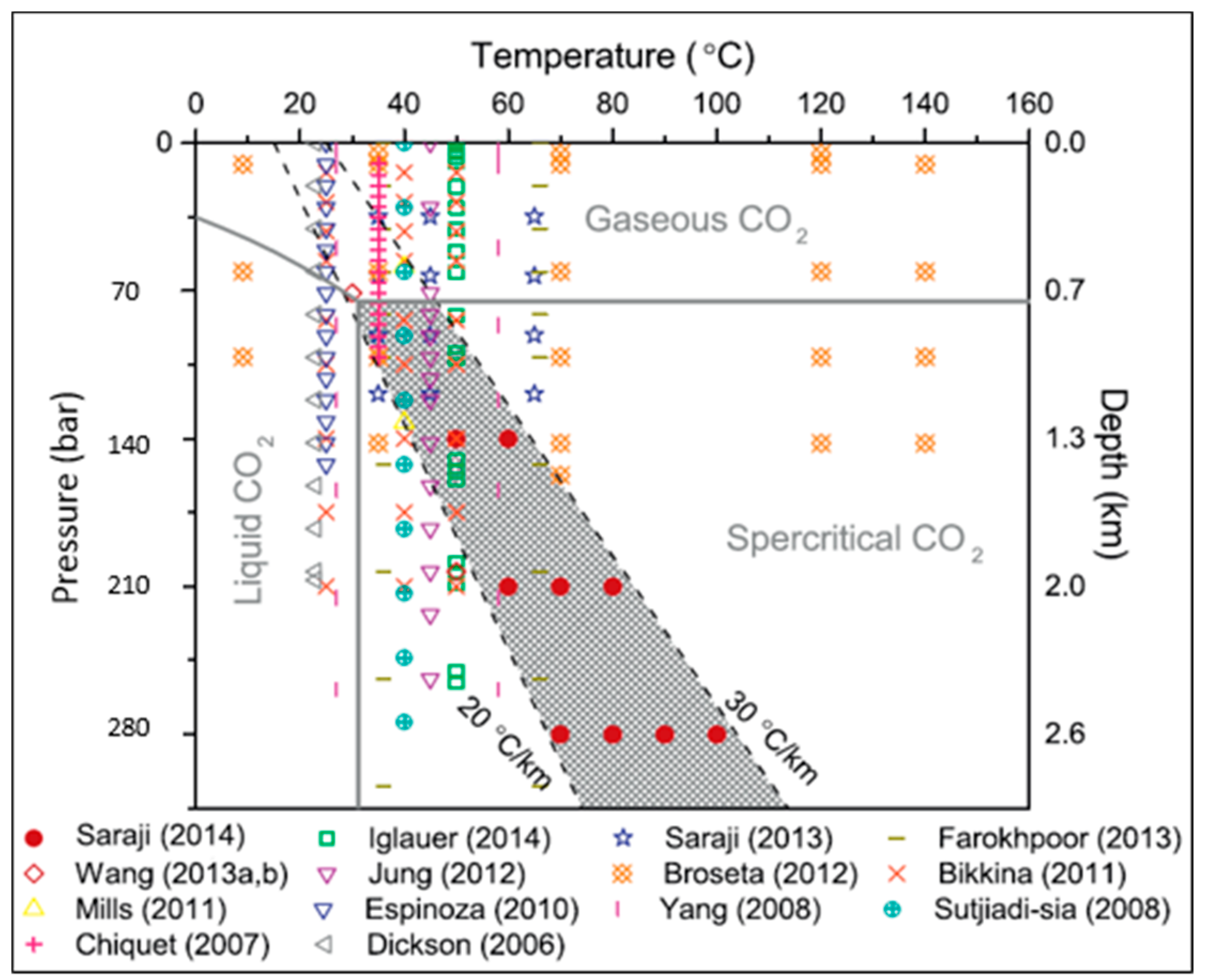
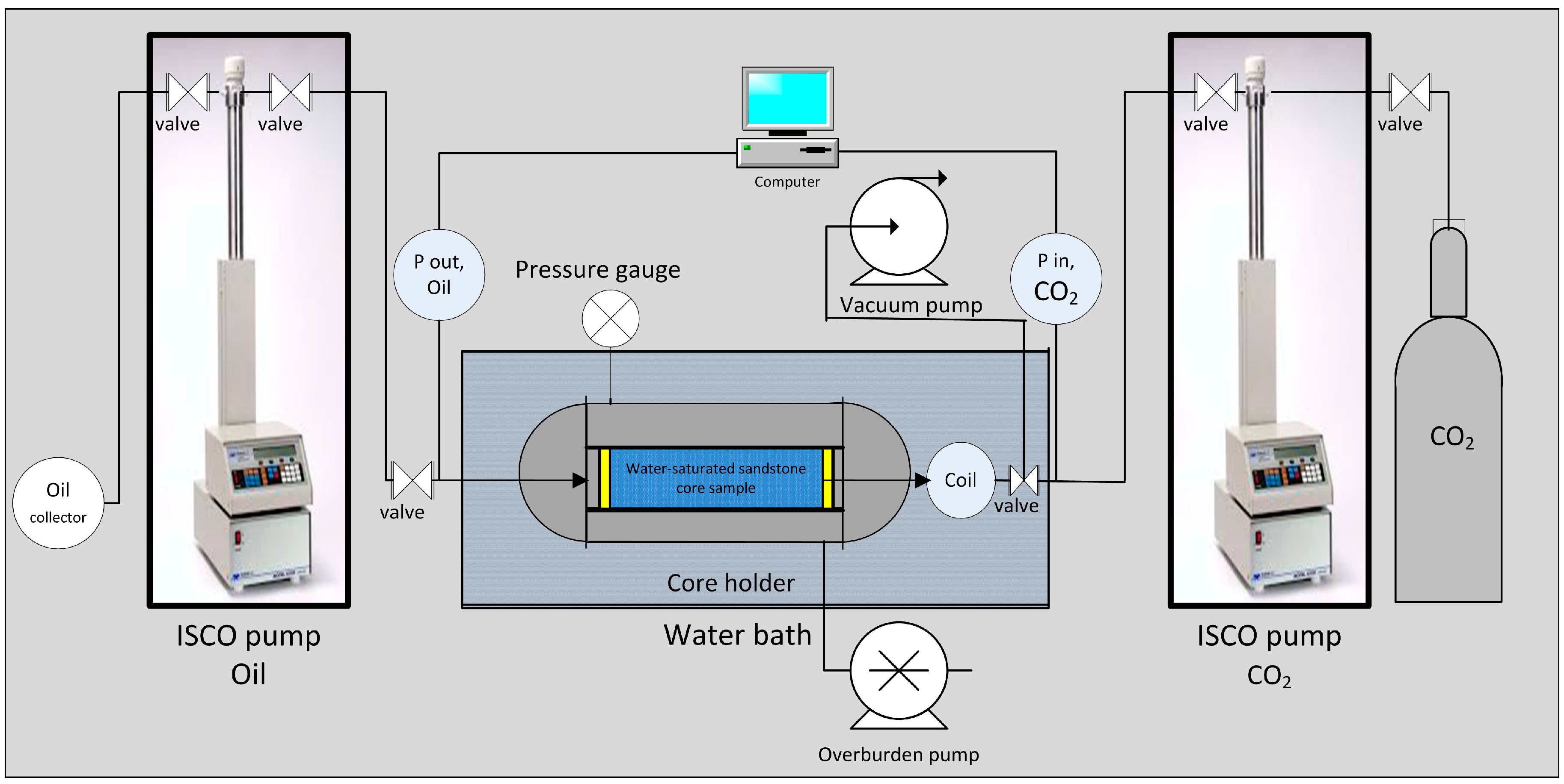
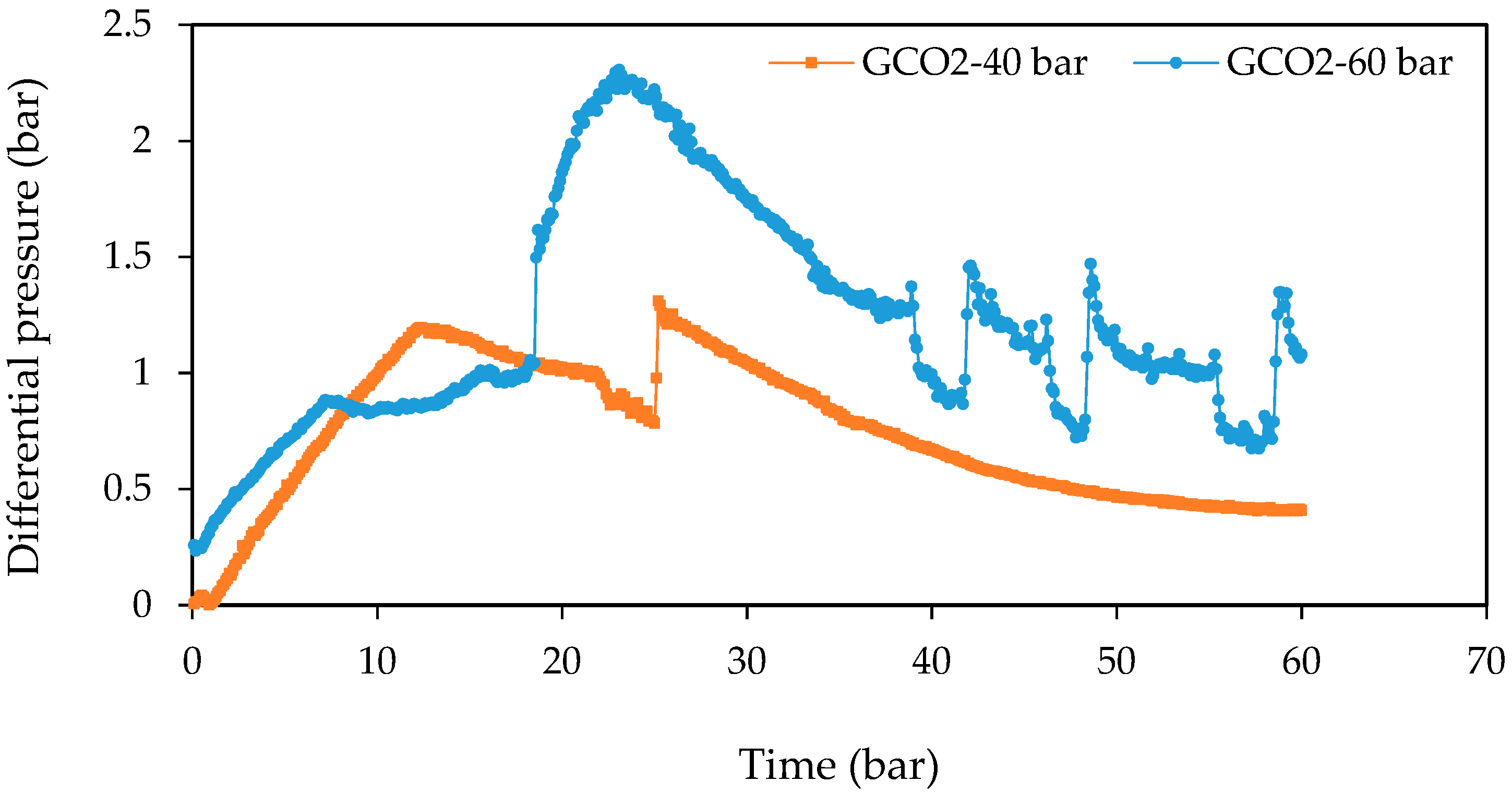
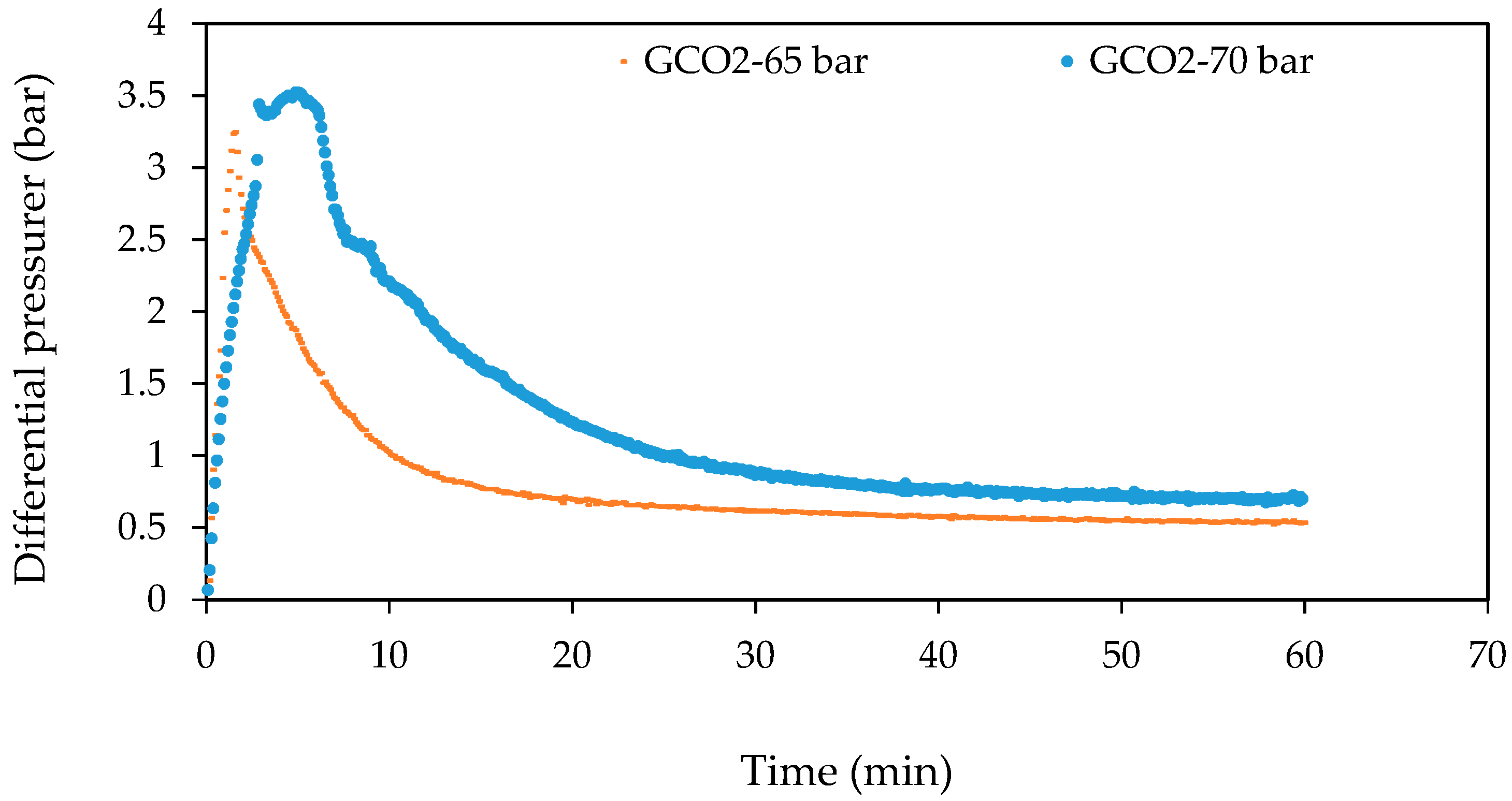
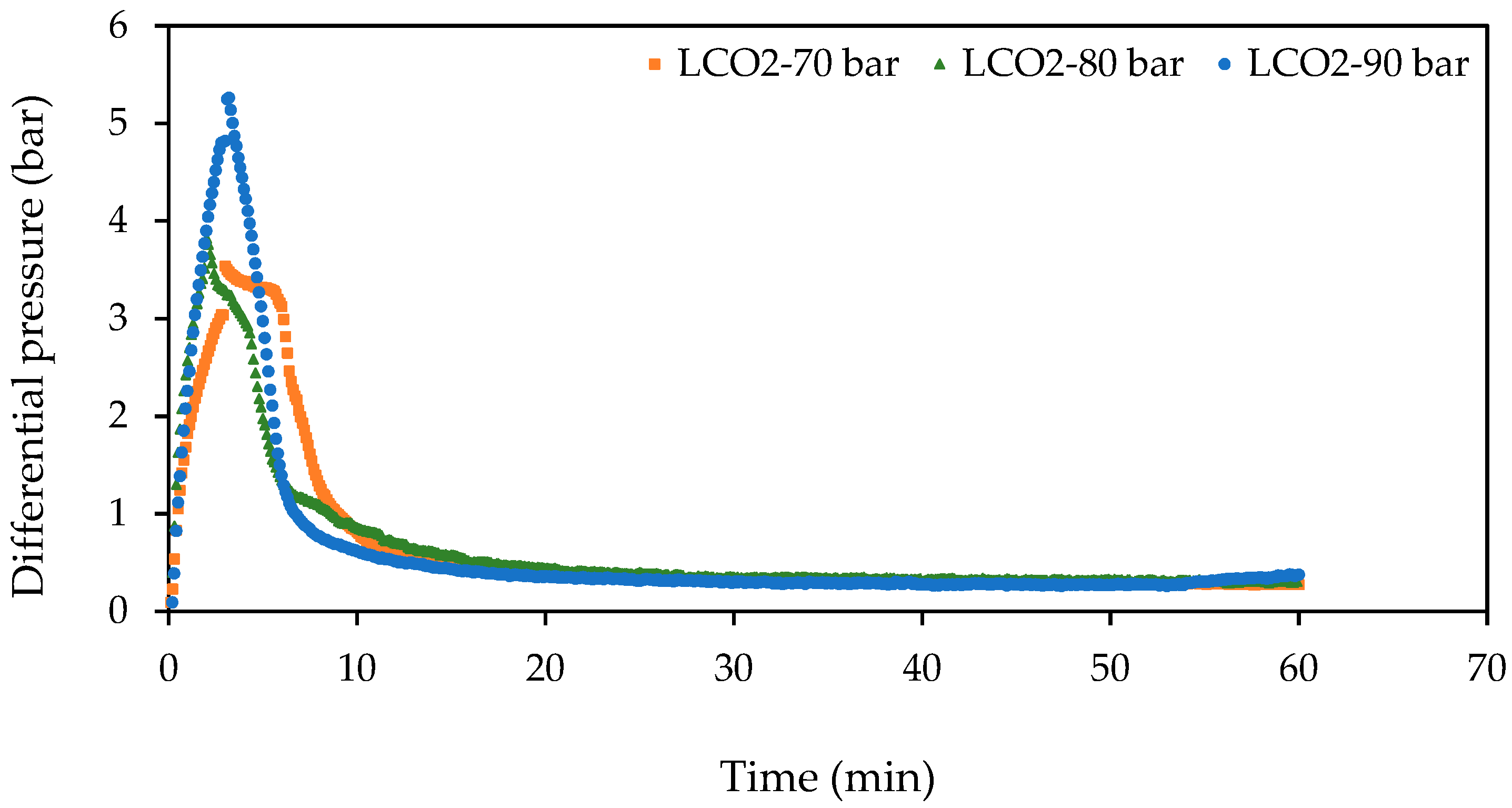
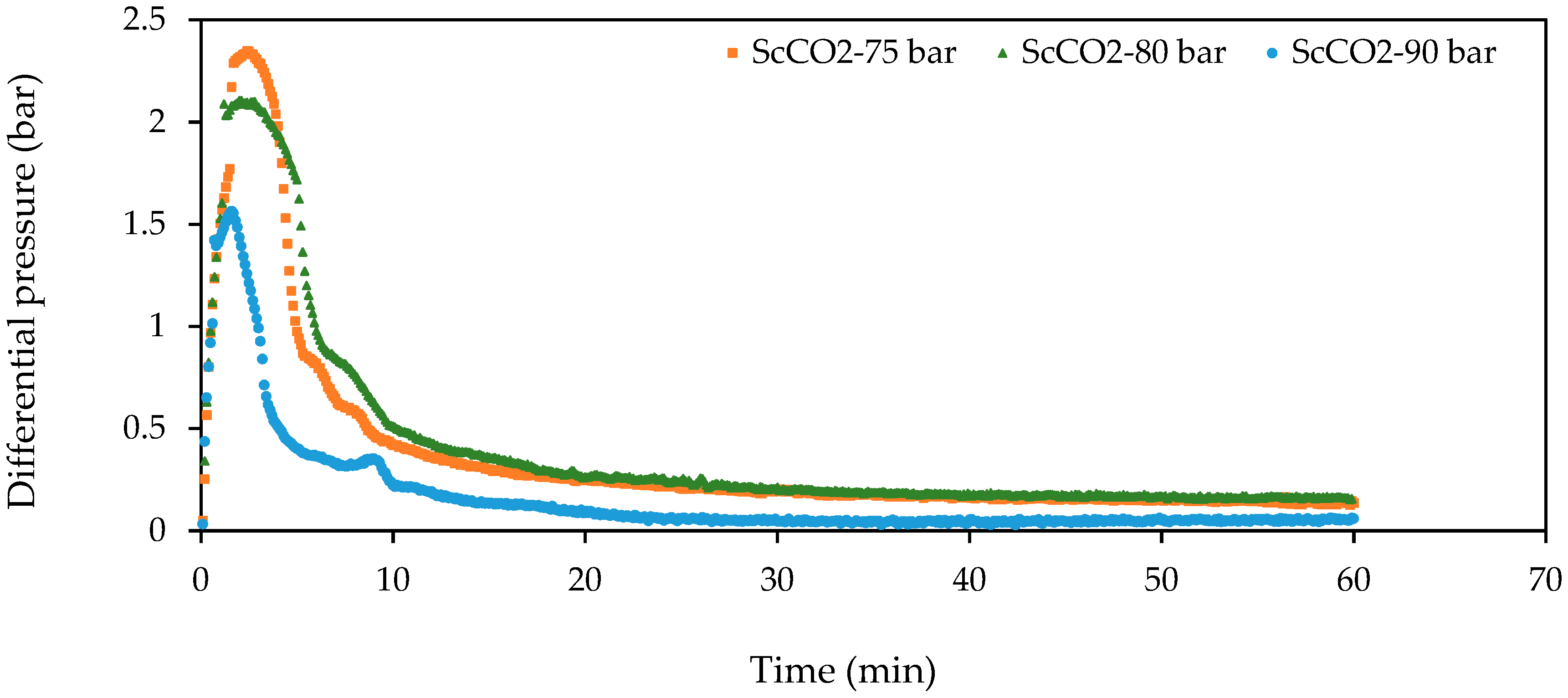
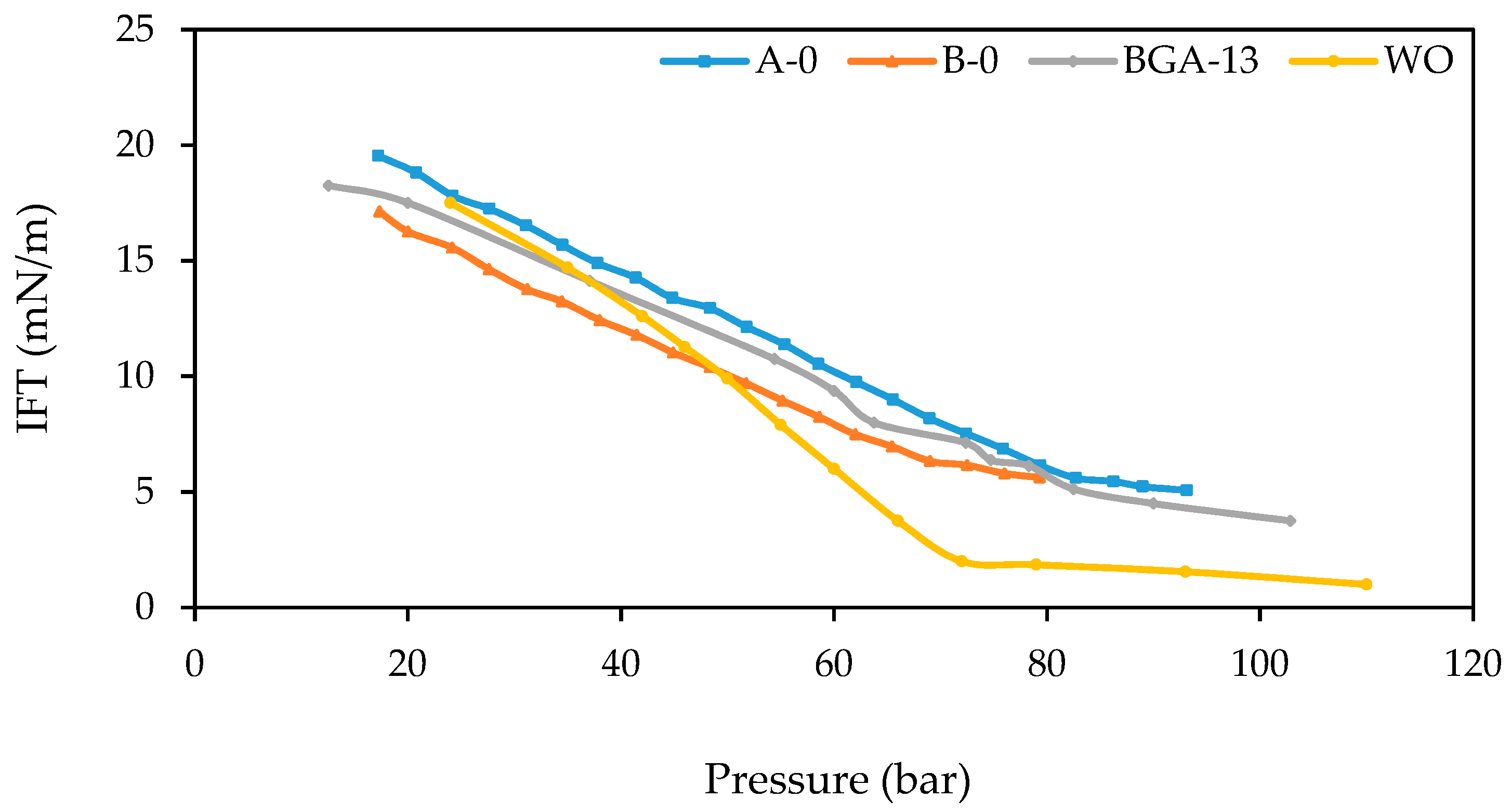

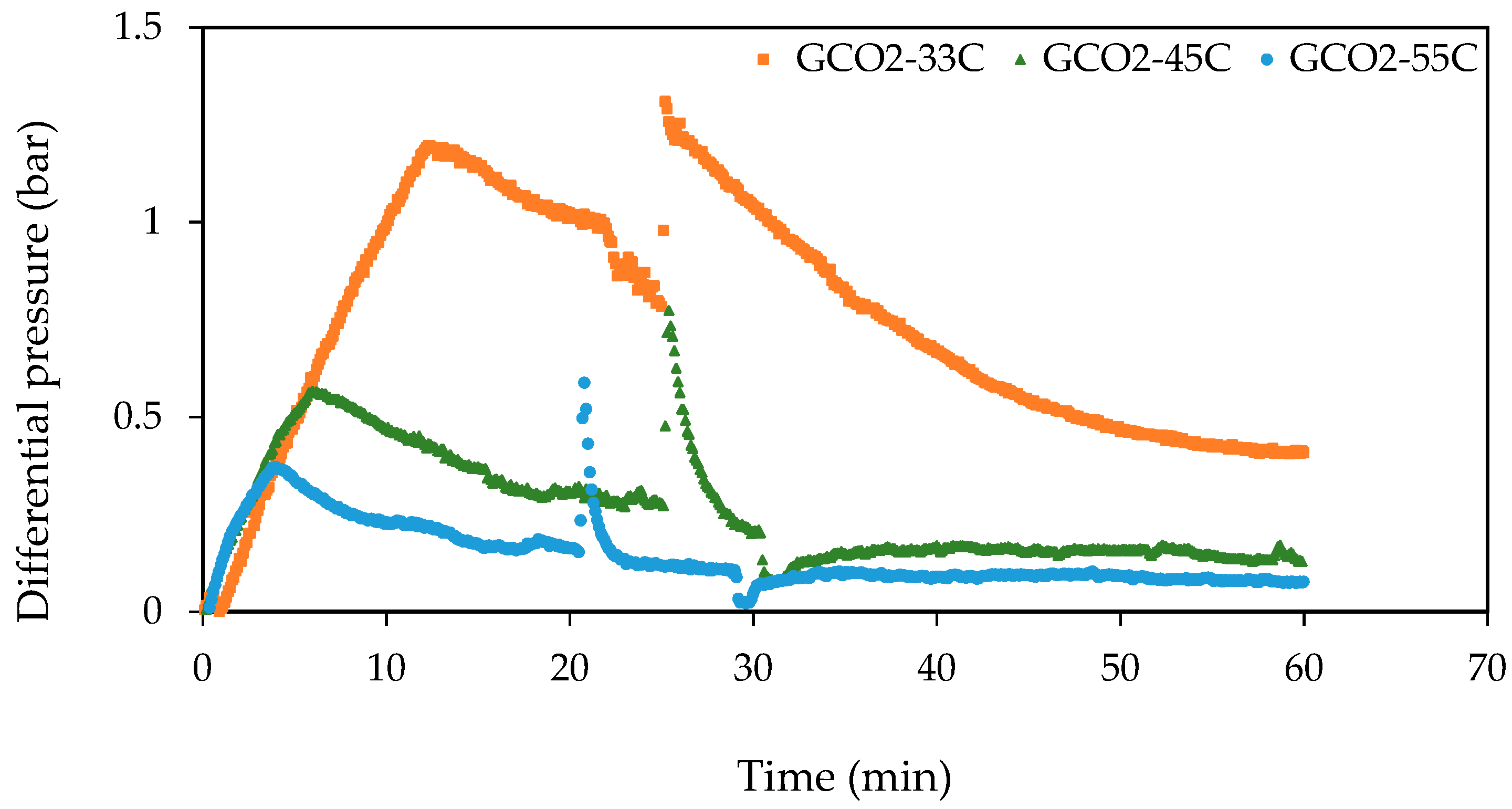
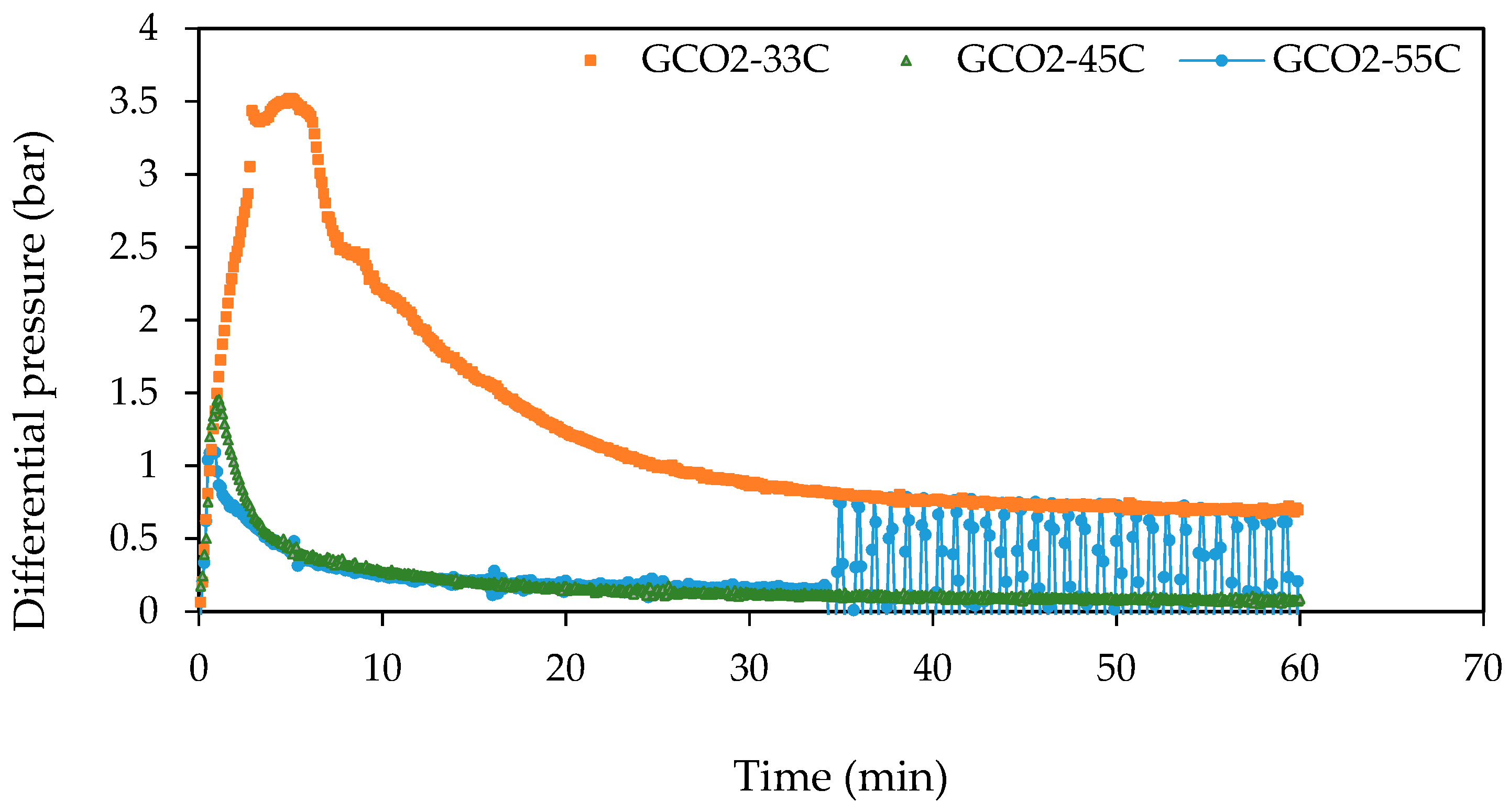
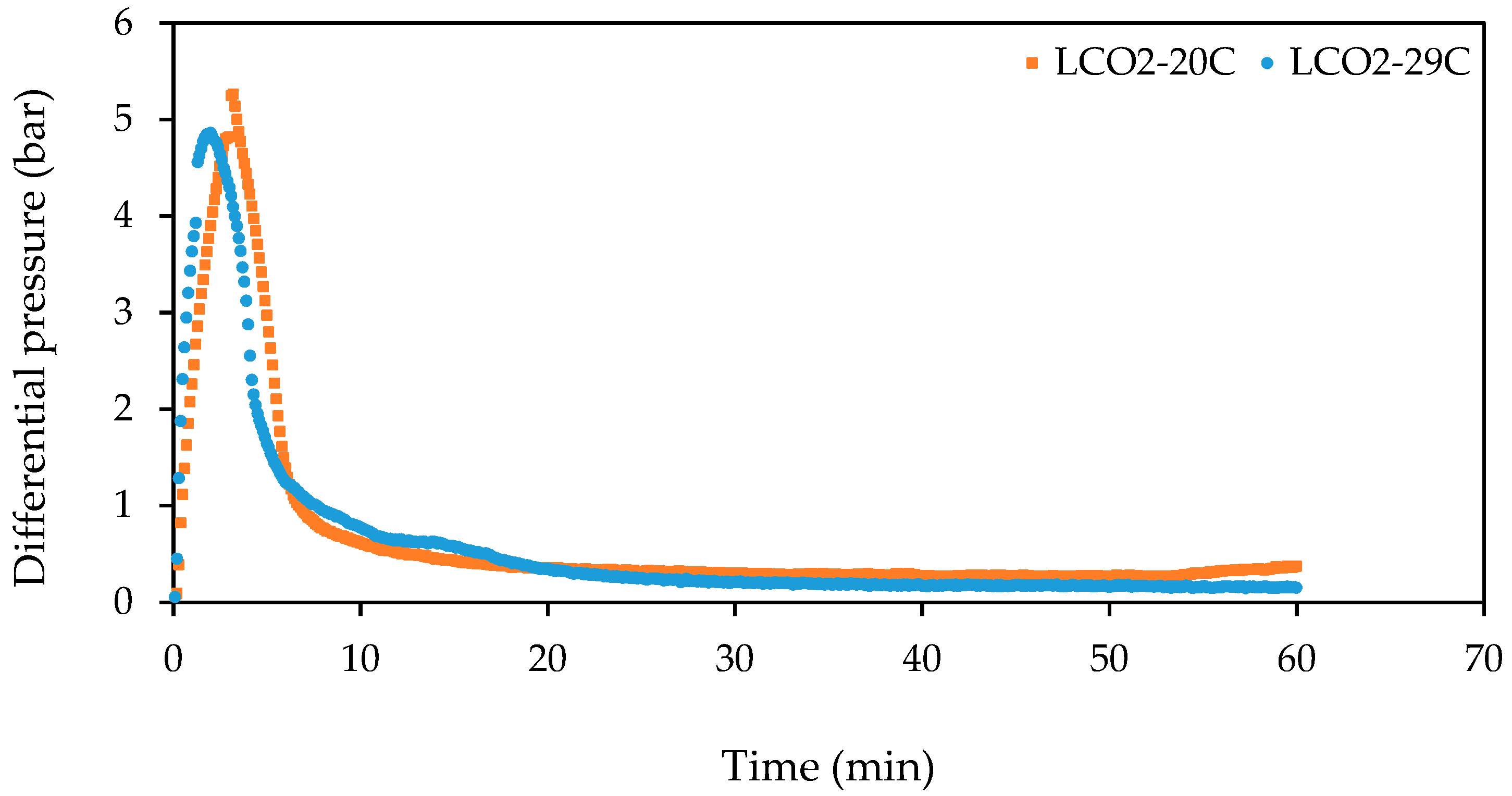
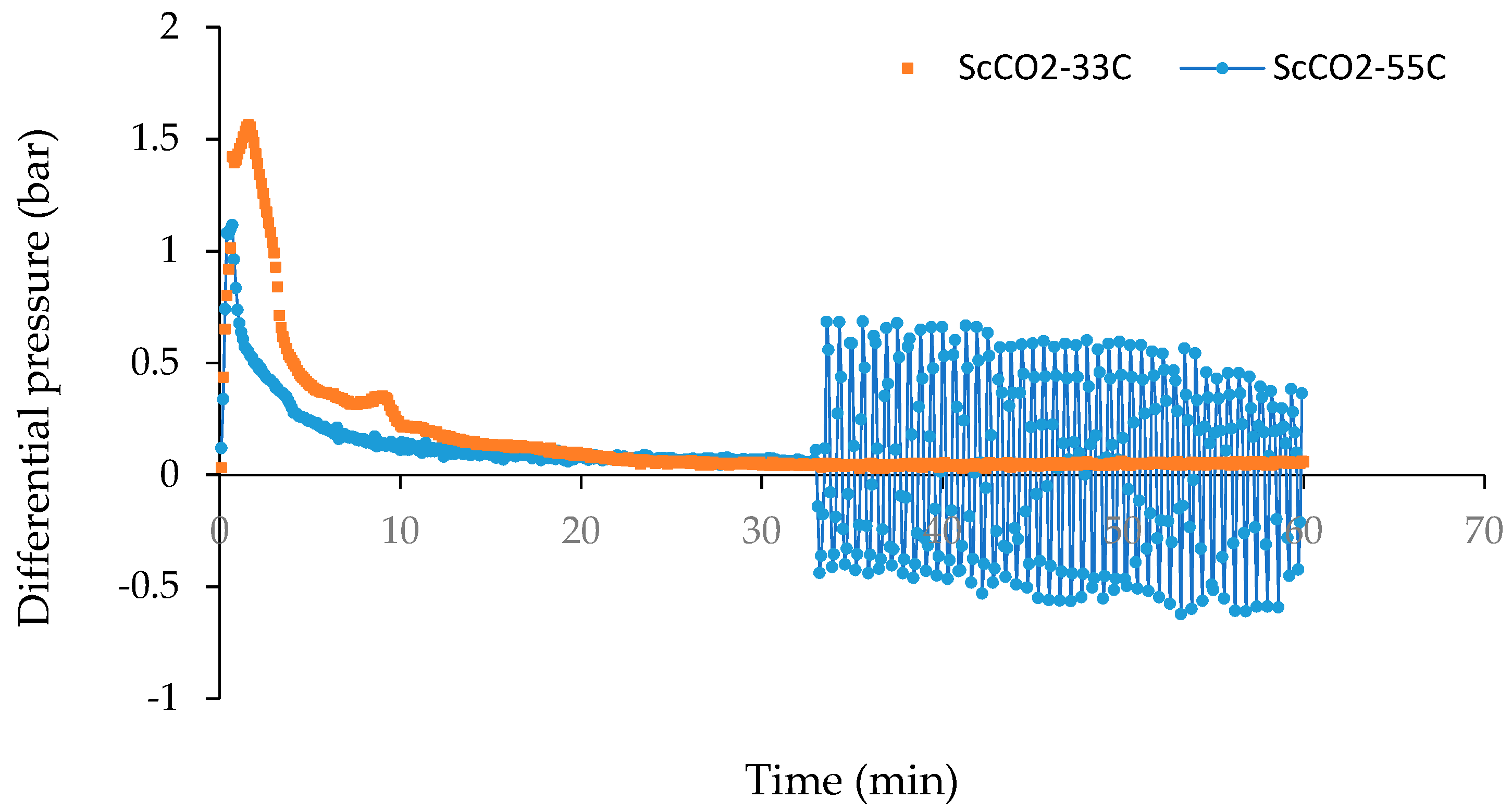
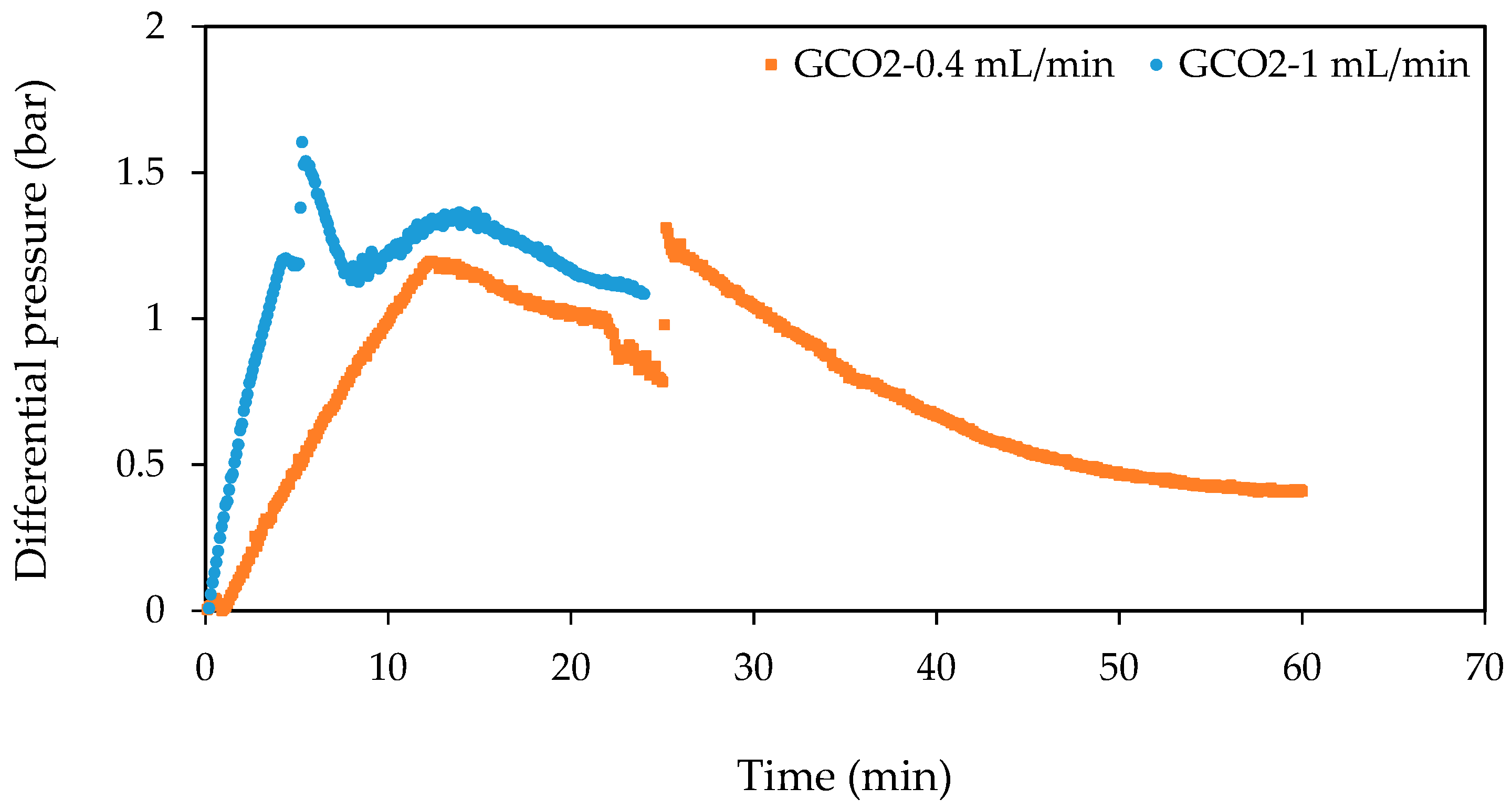
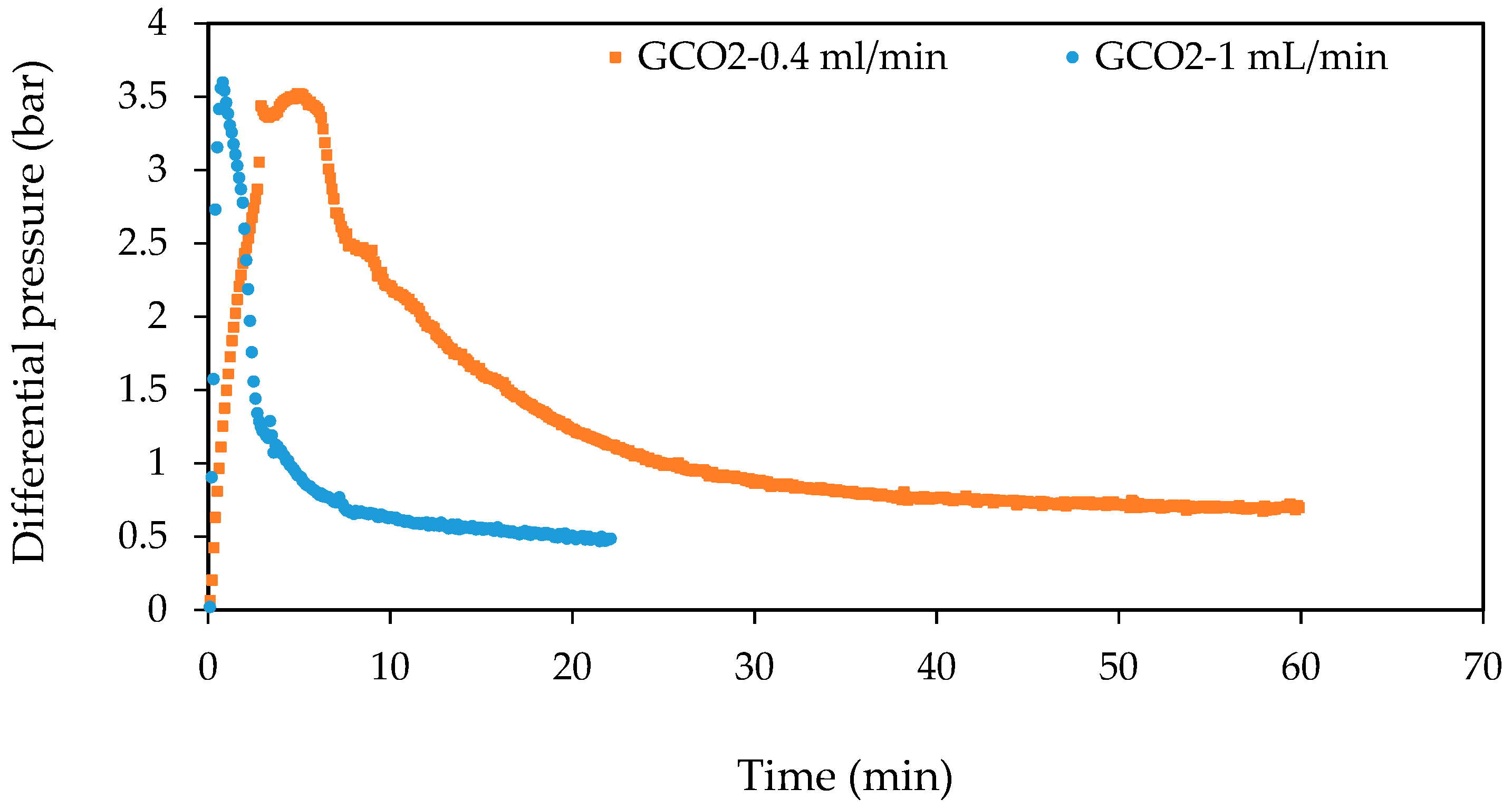
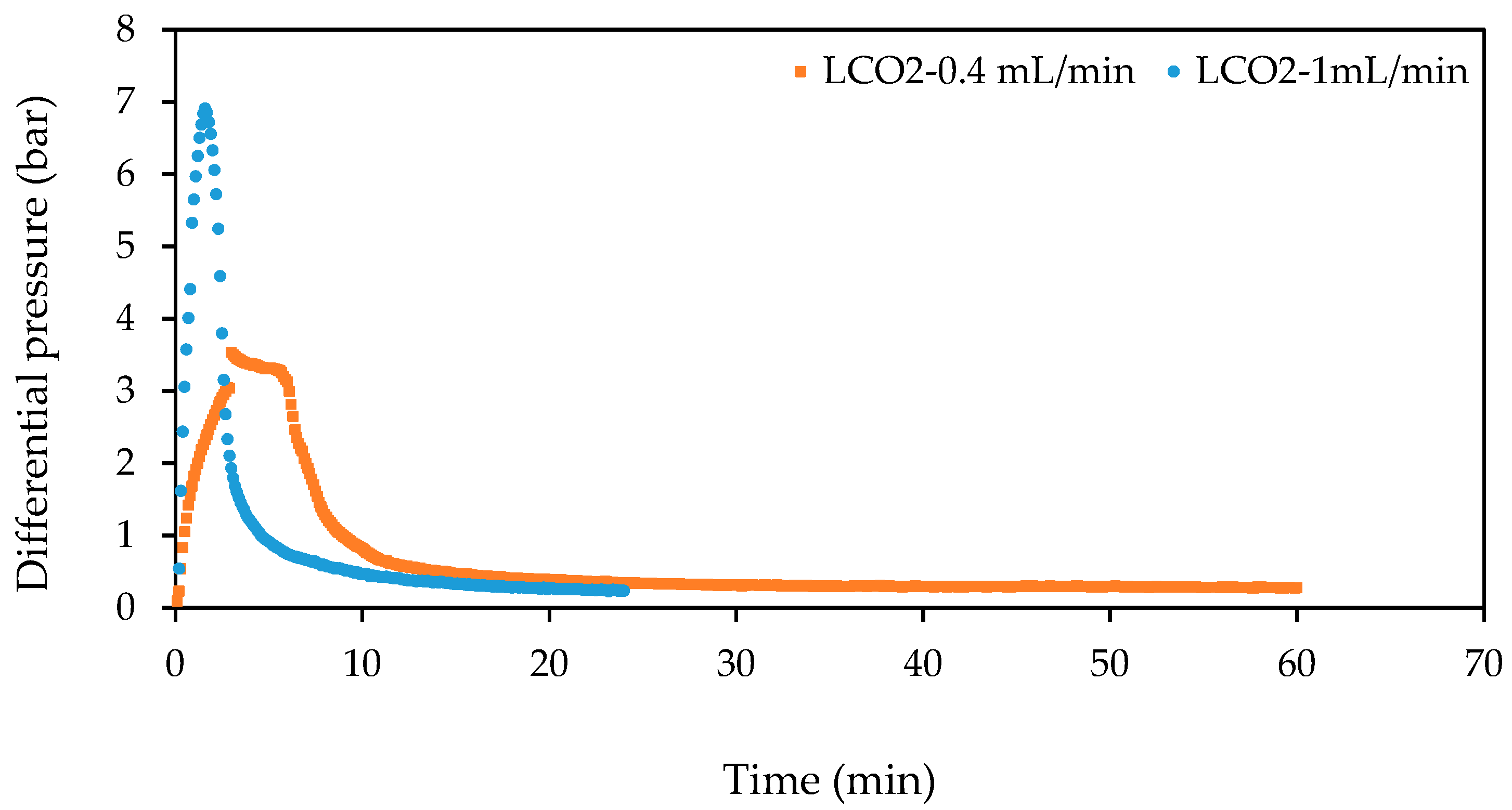

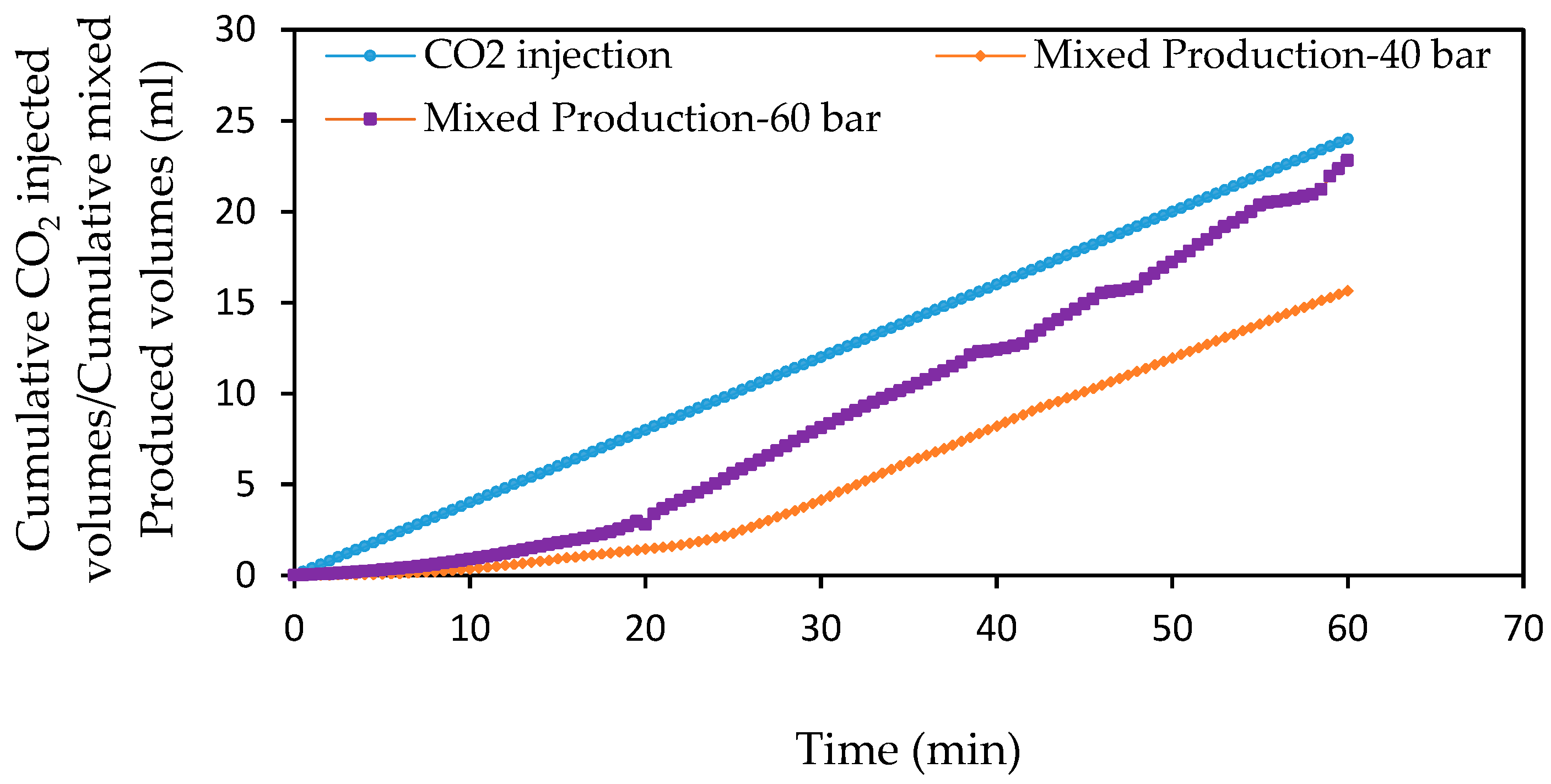
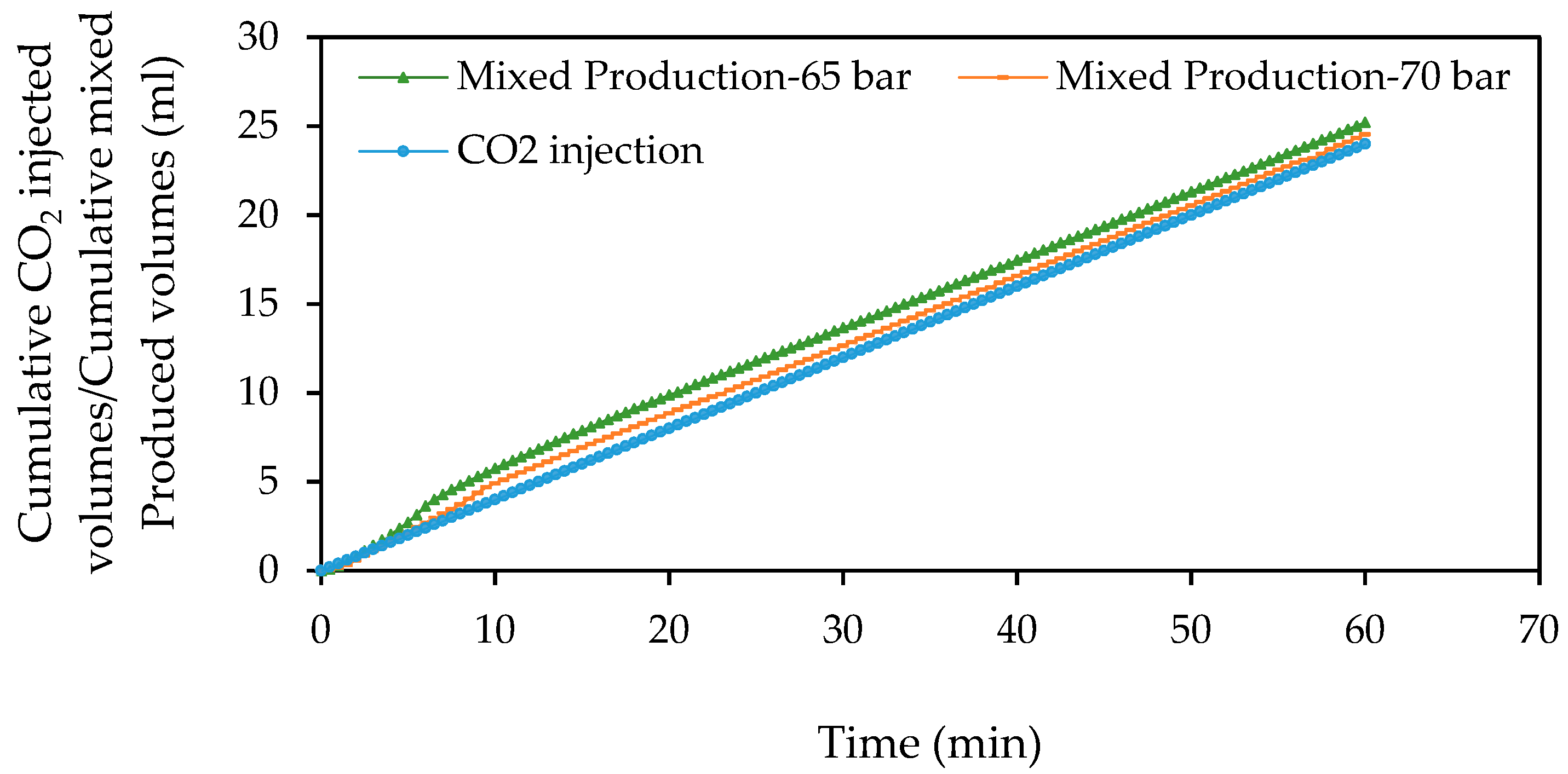
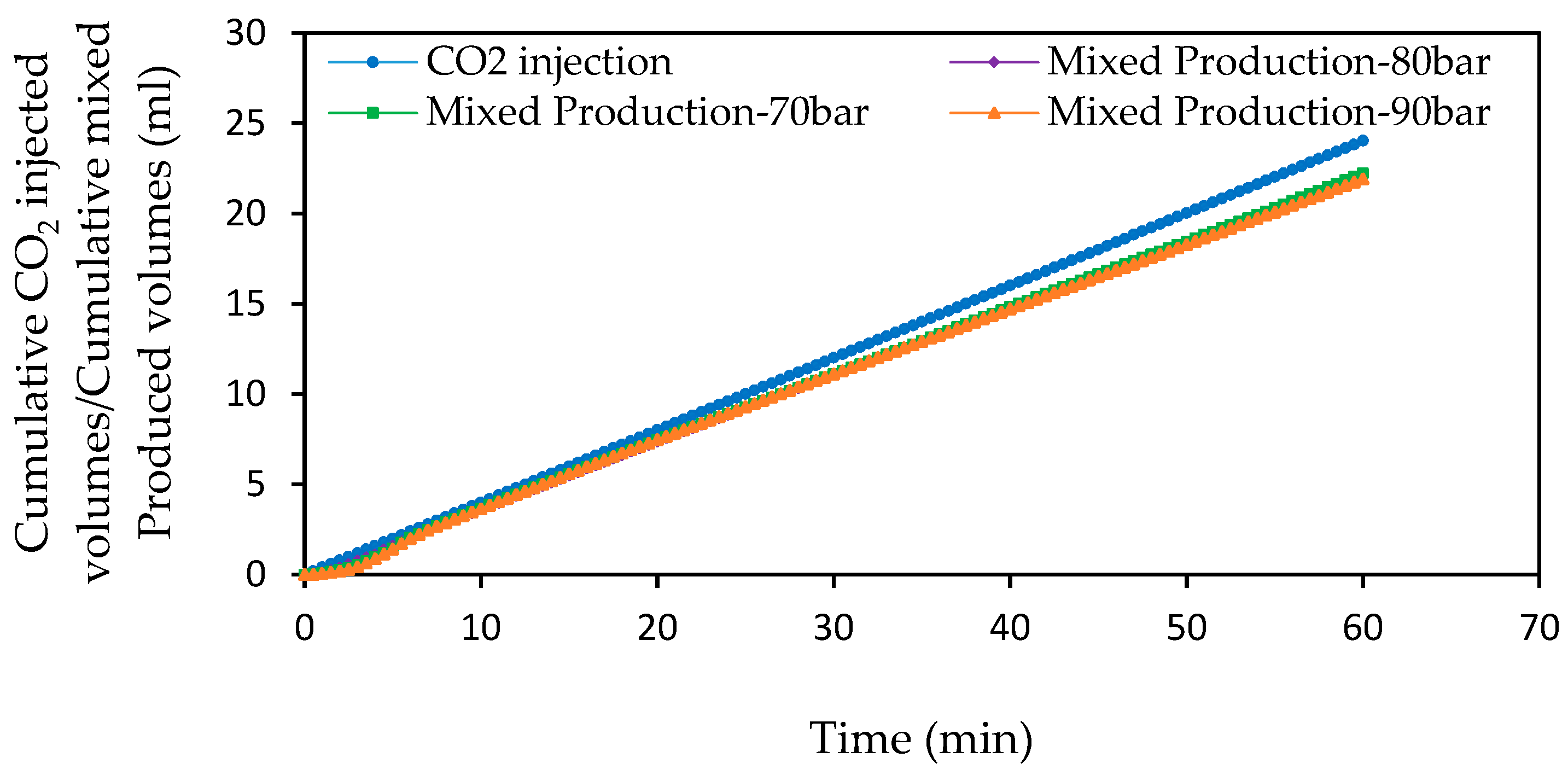

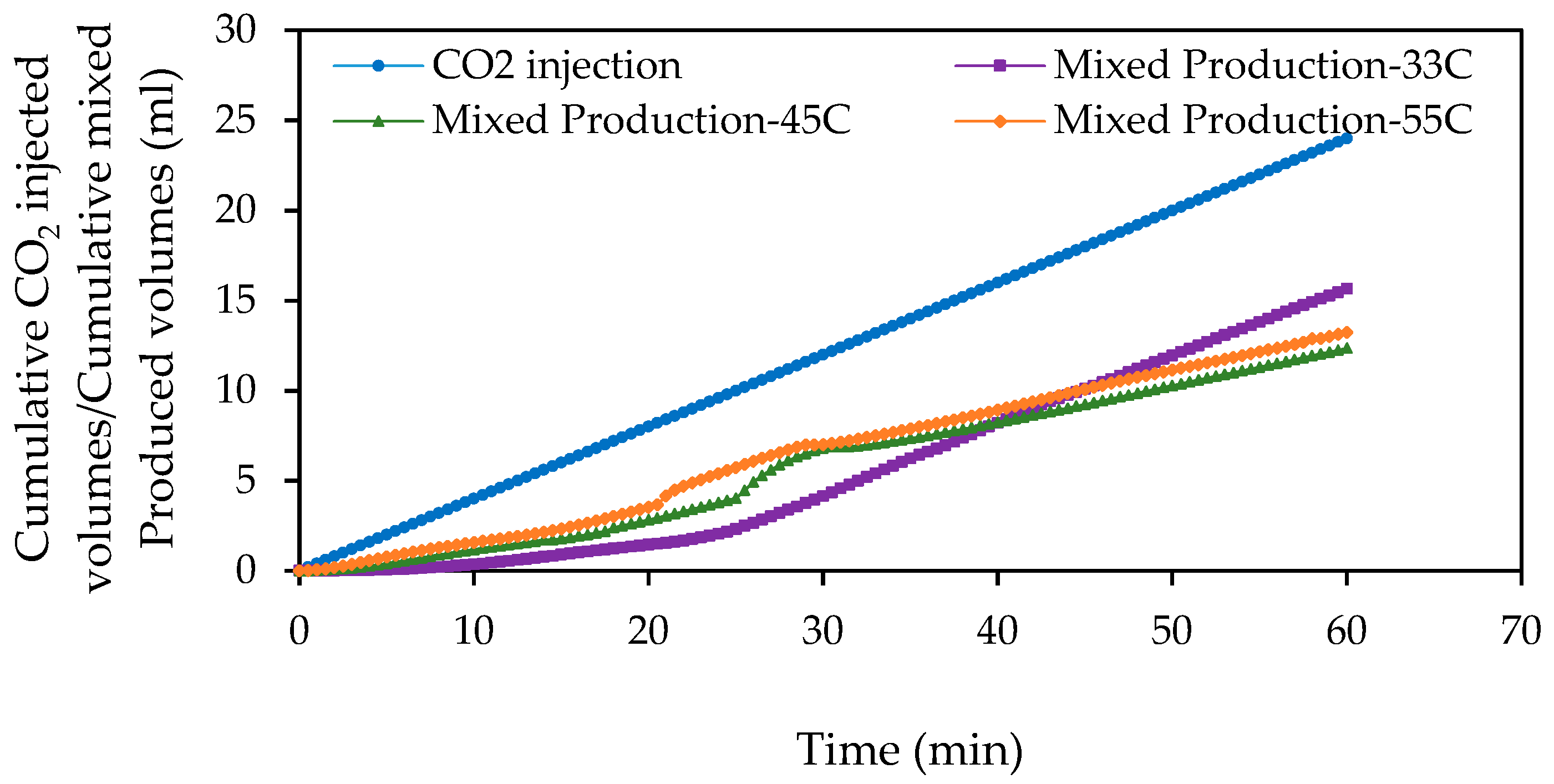
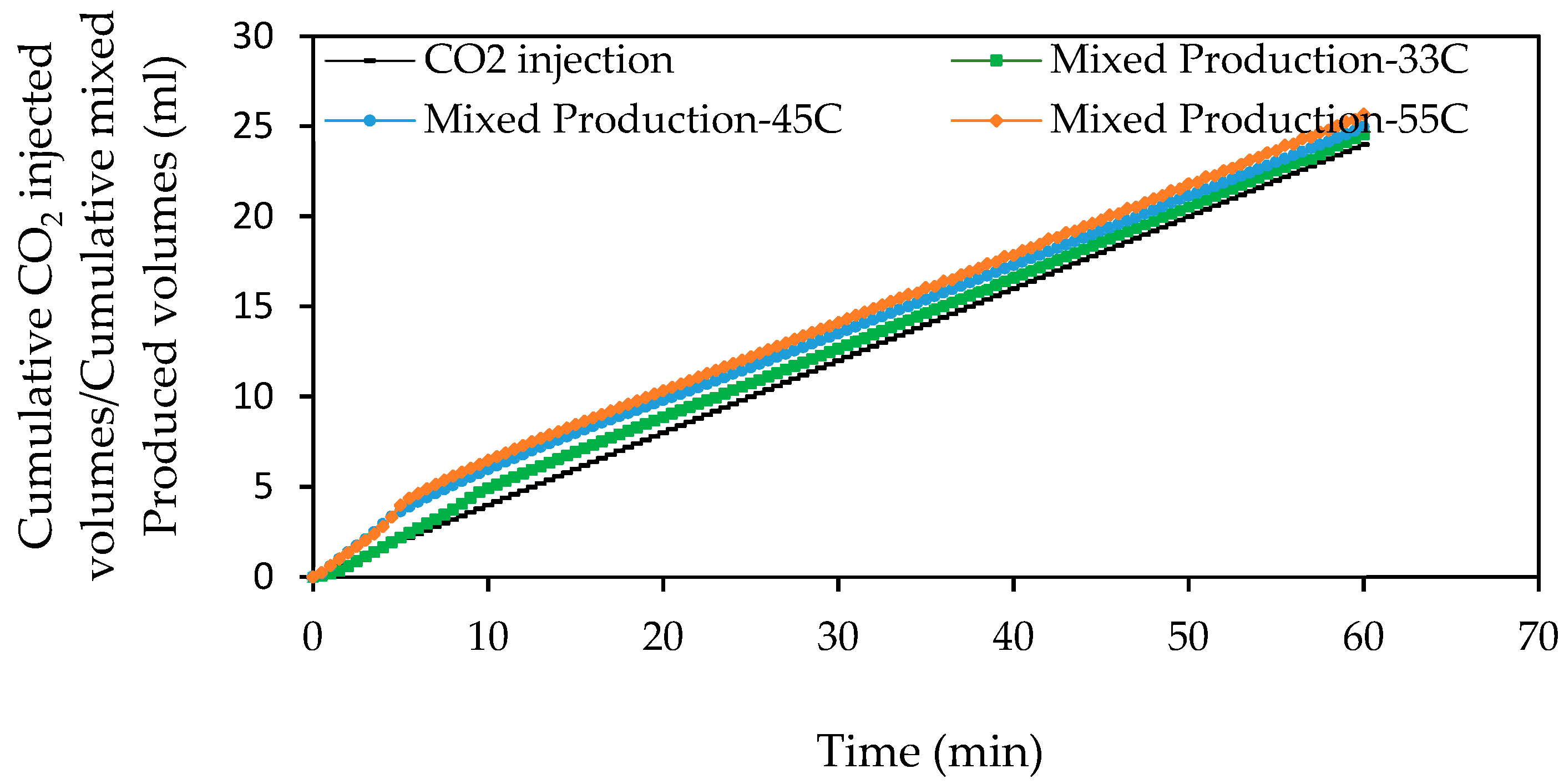
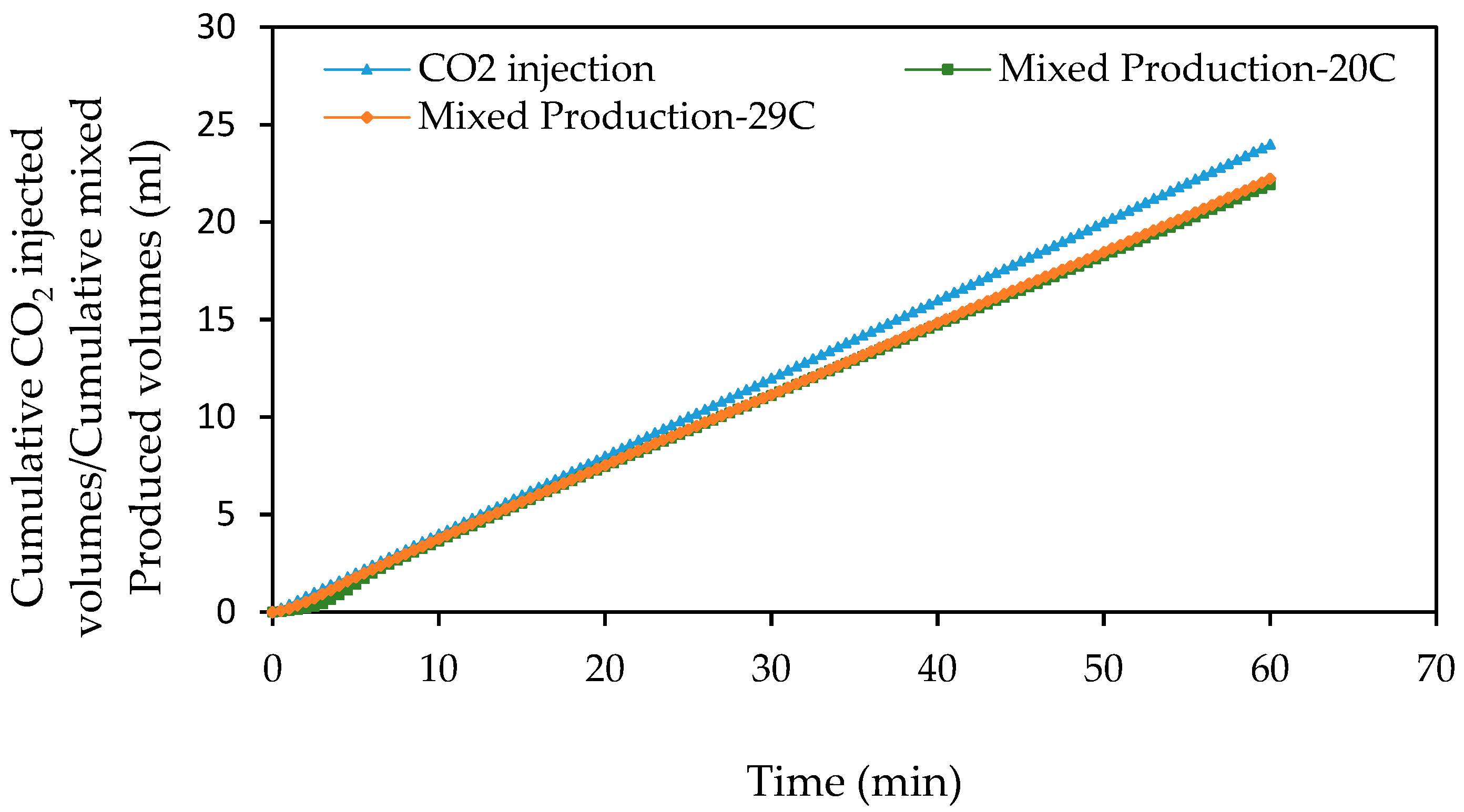
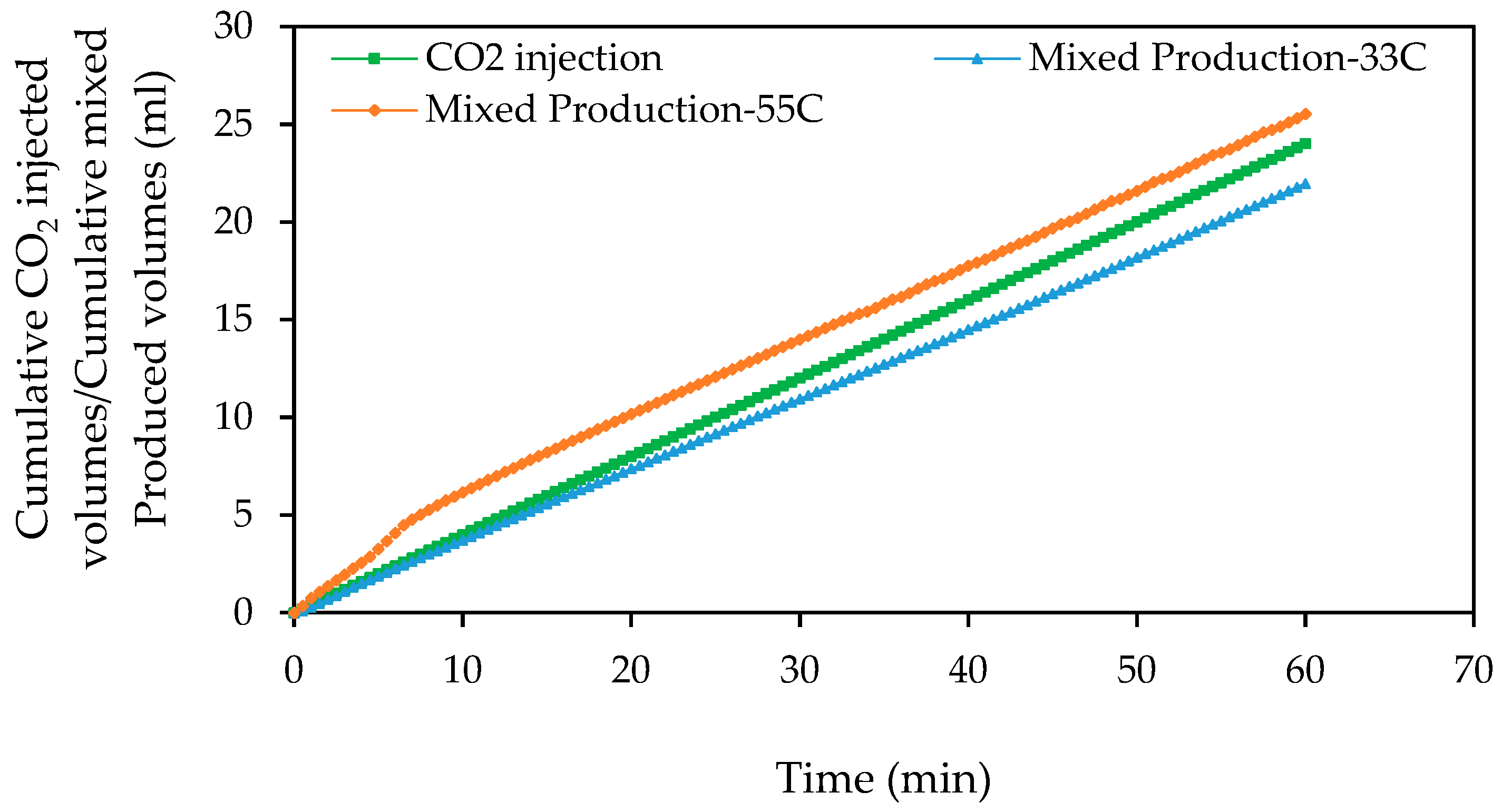
| Parameter | Experiment | KfCO2 (mD) | KrCO2 | Oil Recovery | Sor |
|---|---|---|---|---|---|
| Fluid Pressure Effect | LCO2–oil; 70 bar; 0.4 mL/min; 20 °C | 2.782 | 0.096 | 0.44 | 0.56 |
| LCO2–oil; 90 bar; 0.4 mL/min; 20 °C | 2.287 | 0.079 | 0.56 | 0.44 | |
| GCO2–oil; 40 bar; 0.4 mL/min; 33 °C | 0.446 | 0.015 | 0.30 | 0.70 | |
| GCO2–oil; 60 bar; 0.4 mL/min; 33 °C | 0.822 | 0.028 | 0.35 | 0.65 | |
| GCO2–oil; 65 bar; 0.4 mL/min; 33 °C | 1.417 | 0.049 | 0.40 | 0.60 | |
| GCO2–oil; 70 bar; 0.4 mL/min; 33 °C | 0.991 | 0.034 | 0.41 | 0.59 | |
| ScCO2–oil; 75 bar; 0.4 mL/min; 33 °C | 4.996 | 0.173 | 0.45 | 0.55 | |
| ScCO2–oil; 80 bar; 0.4 mL/min; 33 °C | 4.167 | 0.144 | 0.51 | 0.49 | |
| ScCO2–oil; 90 bar; 0.4 mL/min; 33 °C | 11.717 | 0.406 | 0.41 | 0.59 | |
| Temperature Effect | LCO2–oil; 90 bar; 0.4 mL/min; 20 °C | 2.287 | 0.079 | 0.56 | 0.44 |
| LCO2–oil; 90 bar; 0.4 mL/min; 29 °C | 4.710 | 0.163 | 0.44 | 0.56 | |
| GCO2–oil; 40 bar; 0.4 mL/min; 33 °C | 0.446 | 0.015 | 0.30 | 0.70 | |
| GCO2–oil; 40 bar; 0.4 mL/min; 45 °C | 1.572 | 0.054 | 0.33 | 0.67 | |
| GCO2–oil; 40 bar; 0.4 mL/min; 55 °C | 2.895 | 0.1 | 0.35 | 0.65 | |
| GCO2–oil; 70 bar; 0.4 mL/min; 33 °C | 0.991 | 0.034 | 0.41 | 0.59 | |
| GCO2–oil; 70 bar; 0.4 mL/min; 45 °C | 11.906 | 0.412 | 0.40 | 0.60 | |
| GCO2–oil; 70 bar; 0.4 mL/min; 55 °C | 9.870 | 0.342 | 0.43 | 0.57 | |
| ScCO2–oil; 90 bar; 0.4 mL/min; 33 °C | 11.717 | 0.405 | 0.41 | 0.59 | |
| ScCO2–oil; 90 bar; 0.4 mL/min; 55 °C | 12.413 | 0.430 | 0.47 | 0.53 | |
| Injection Rate Effect | LCO2–oil; 70 bar; 0.4 mL/min; 20 °C | 2.782 | 0.096 | 0.44 | 0.56 |
| LCO2–oil; 70 bar; 1 mL/min; 20 °C | 8.120 | 0.218 | 0.51 | 0.49 | |
| GCO2–oil; 40 bar; 0.4 mL/min; 33 °C | 0.446 | 0.015 | 0.30 | 0.70 | |
| GCO2–oil; 40 bar; 1 mL/min; 33 °C | 0.420 | 0.015 | 0.32 | 0.68 | |
| GCO2–oil; 70 bar; 0.4 mL/min; 33 °C | 0.991 | 0.034 | 0.41 | 0.59 | |
| GCO2–oil; 70 bar; 1 mL/min; 33 °C | 3.599 | 0.125 | 0.44 | 0.56 | |
| ScCO2–oil; 90 bar; 0.4 mL/min; 33 °C | 11.717 | 0.405 | 0.41 | 0.59 | |
| ScCO2–oil; 90 bar; 1 mL/min; 33°C | 18.992 | 0.657 | 0.51 | 0.49 |
© 2018 by the authors. Licensee MDPI, Basel, Switzerland. This article is an open access article distributed under the terms and conditions of the Creative Commons Attribution (CC BY) license (http://creativecommons.org/licenses/by/4.0/).
Share and Cite
Al-Zaidi, E.; Fan, X.; Edlmann, K. The Effect of CO2 Phase on Oil Displacement in a Sandstone Core Sample. Fluids 2018, 3, 23. https://doi.org/10.3390/fluids3010023
Al-Zaidi E, Fan X, Edlmann K. The Effect of CO2 Phase on Oil Displacement in a Sandstone Core Sample. Fluids. 2018; 3(1):23. https://doi.org/10.3390/fluids3010023
Chicago/Turabian StyleAl-Zaidi, Ebraheam, Xianfeng Fan, and Katriona Edlmann. 2018. "The Effect of CO2 Phase on Oil Displacement in a Sandstone Core Sample" Fluids 3, no. 1: 23. https://doi.org/10.3390/fluids3010023





